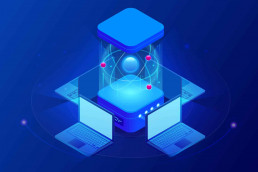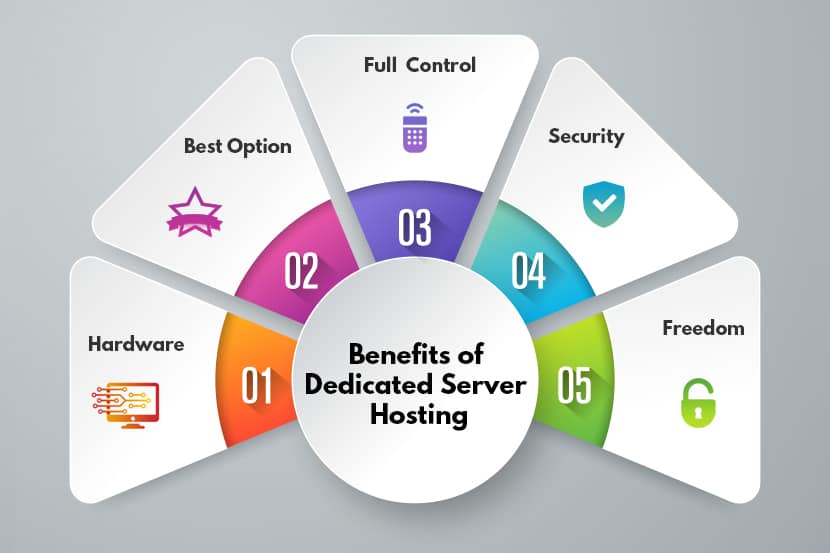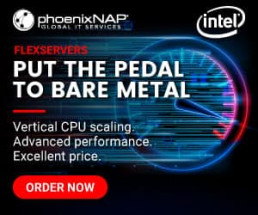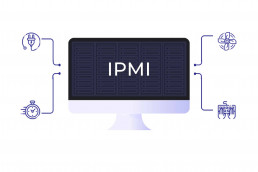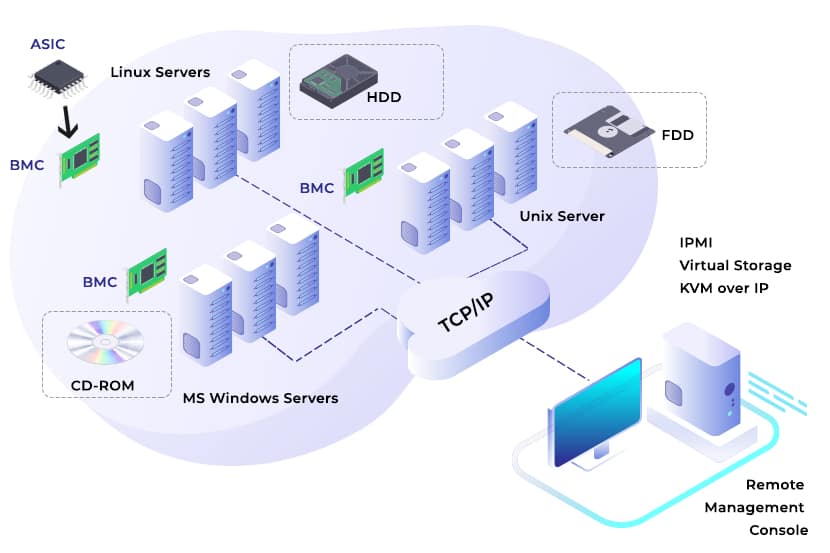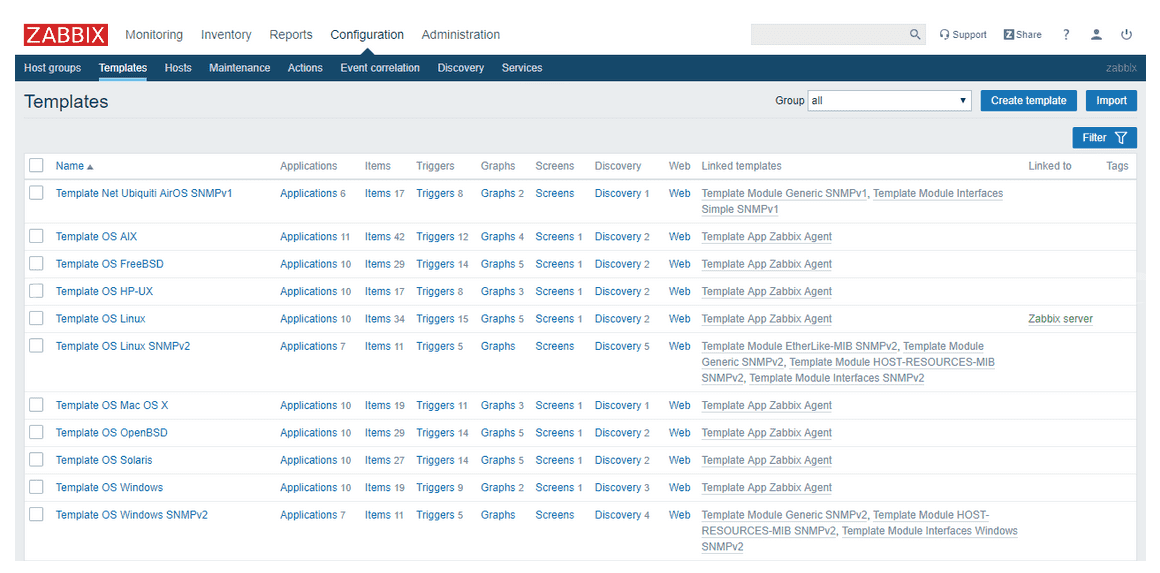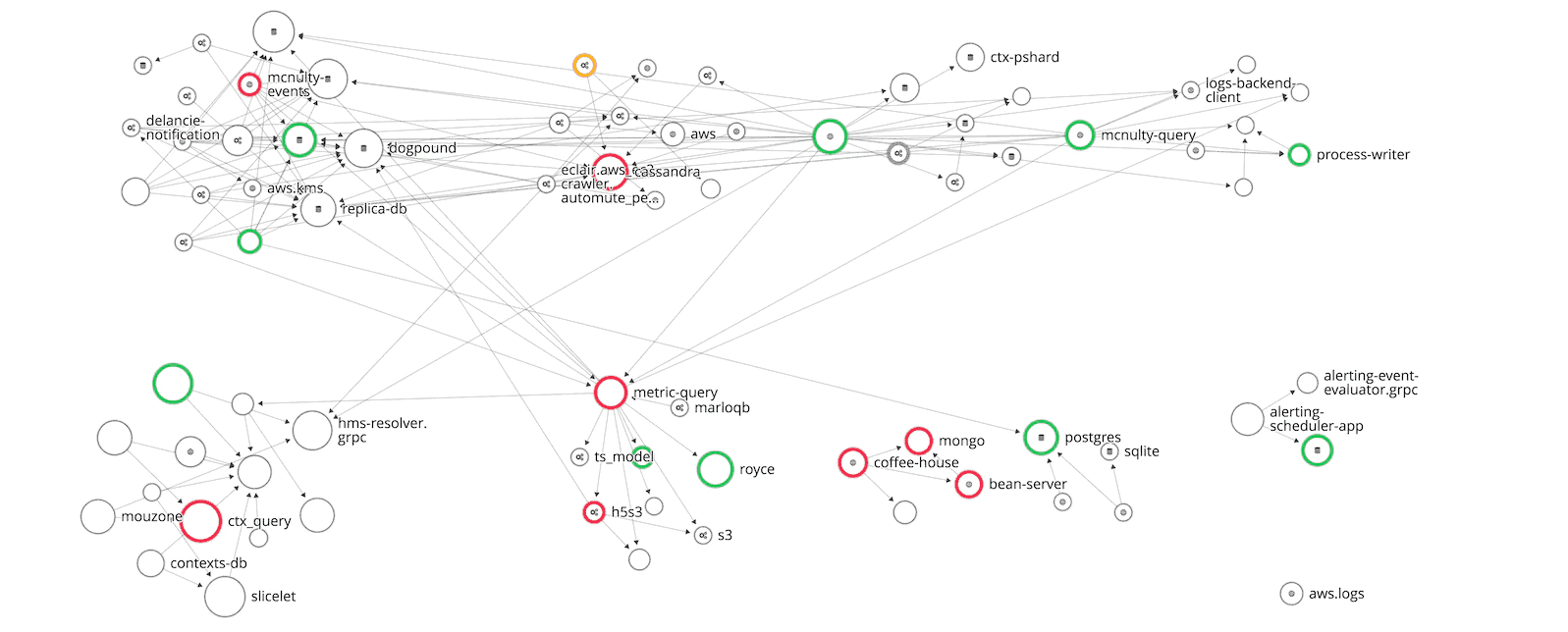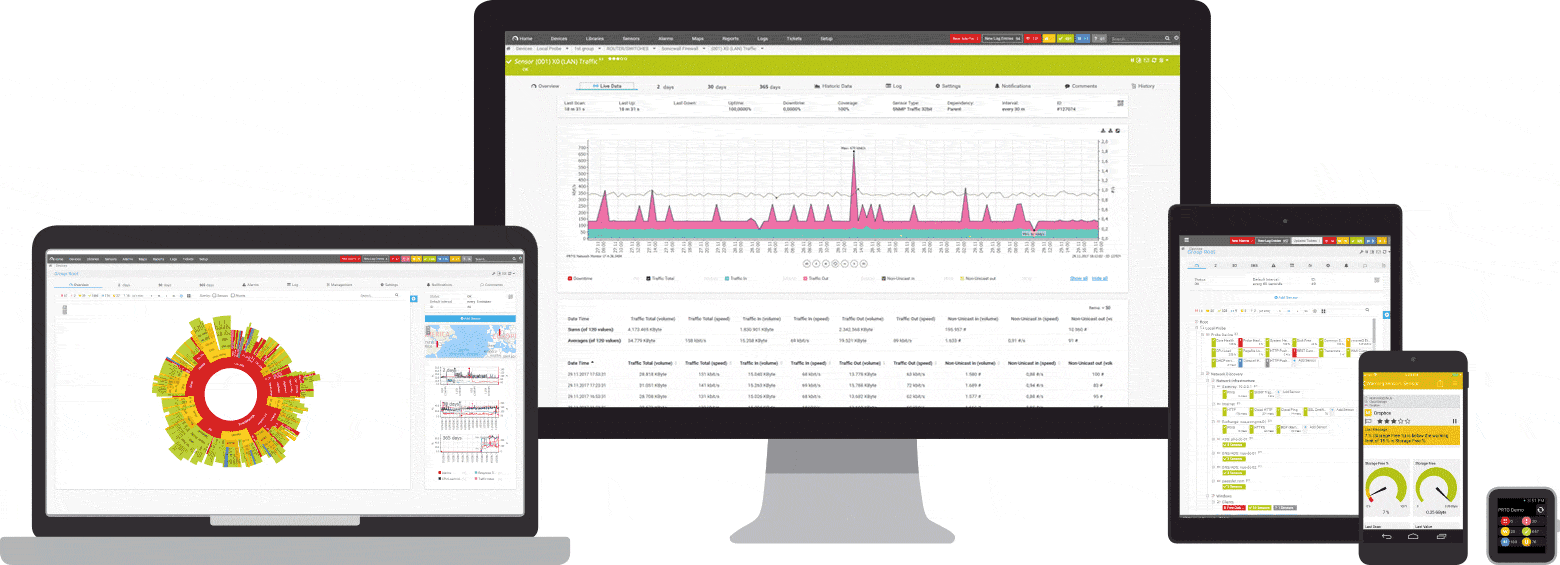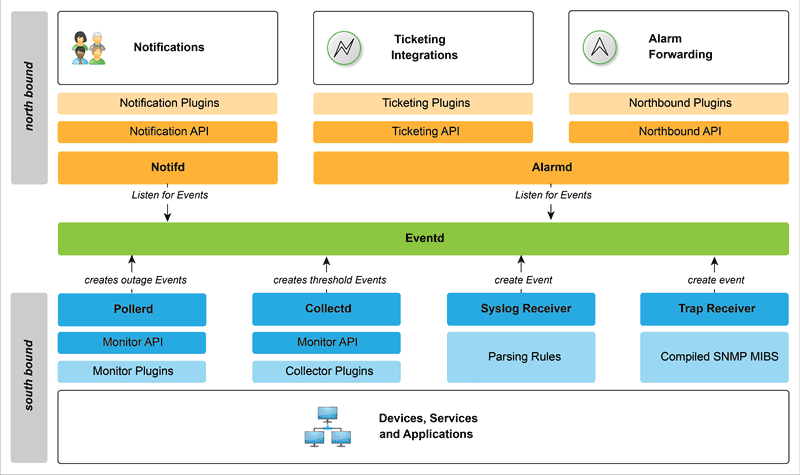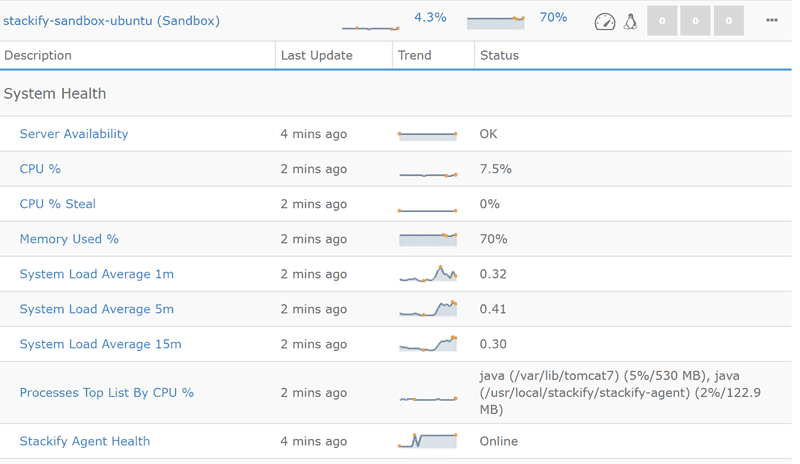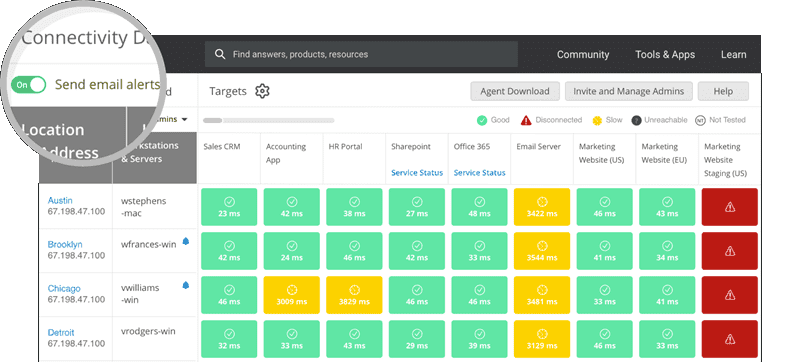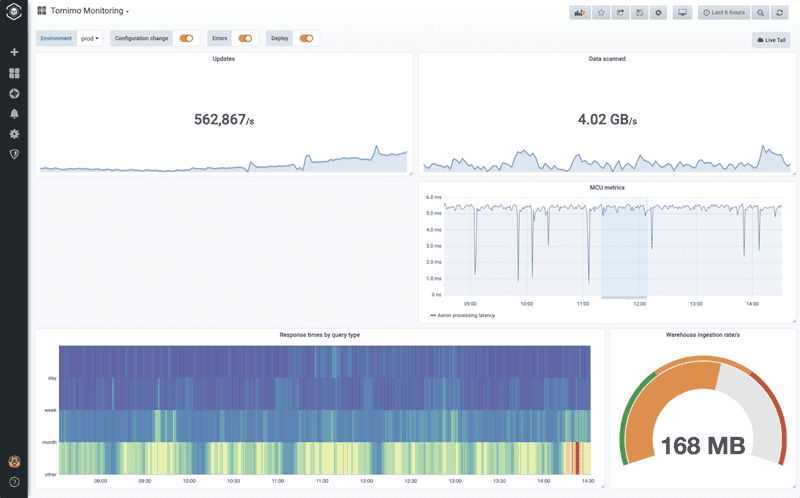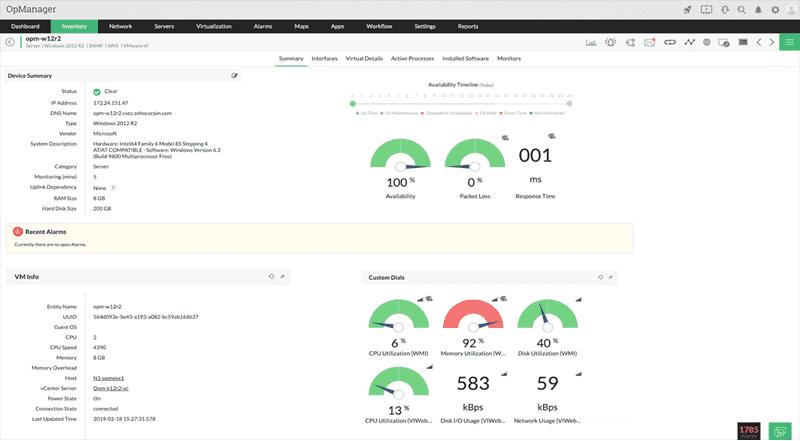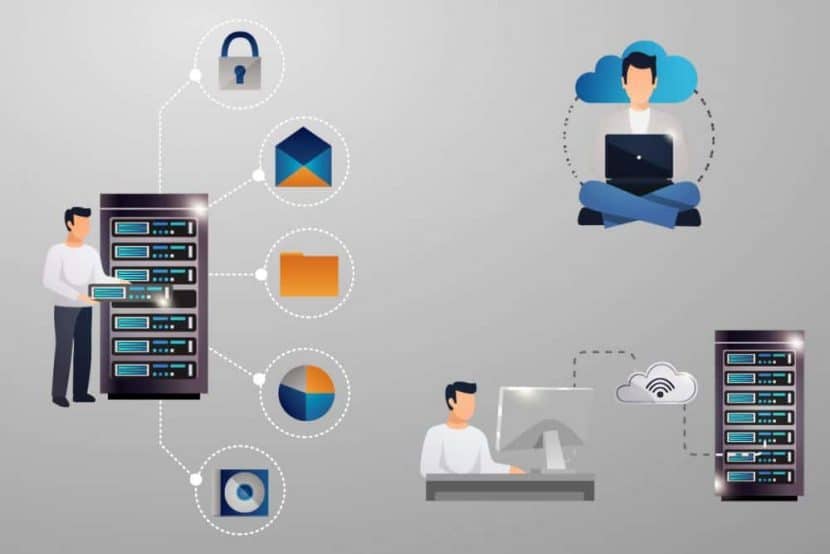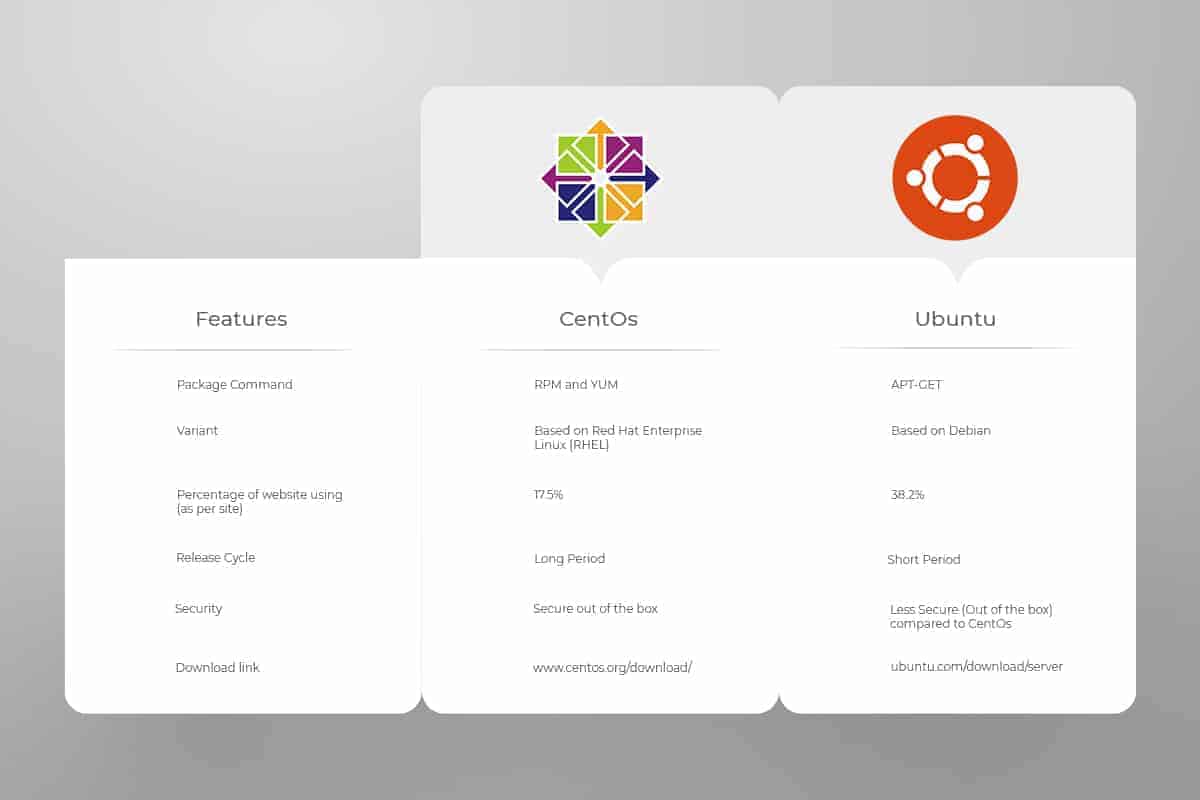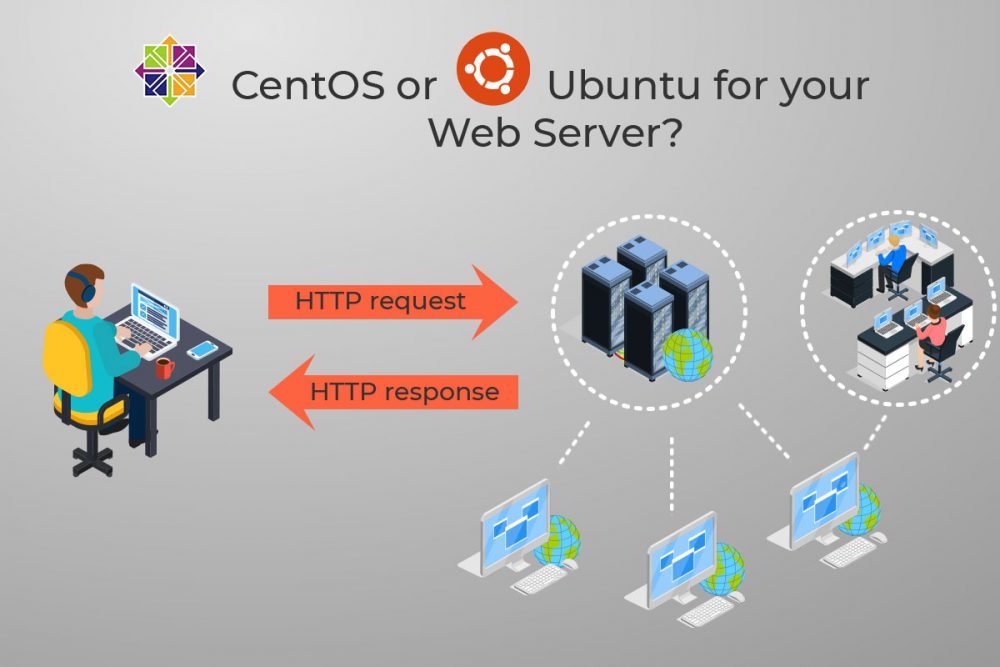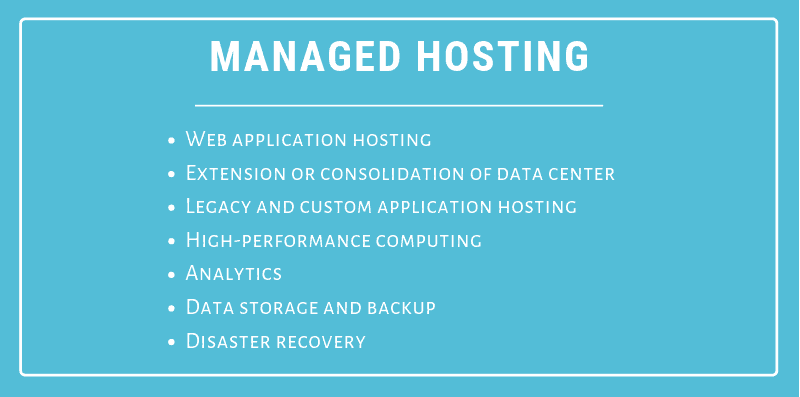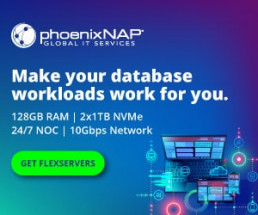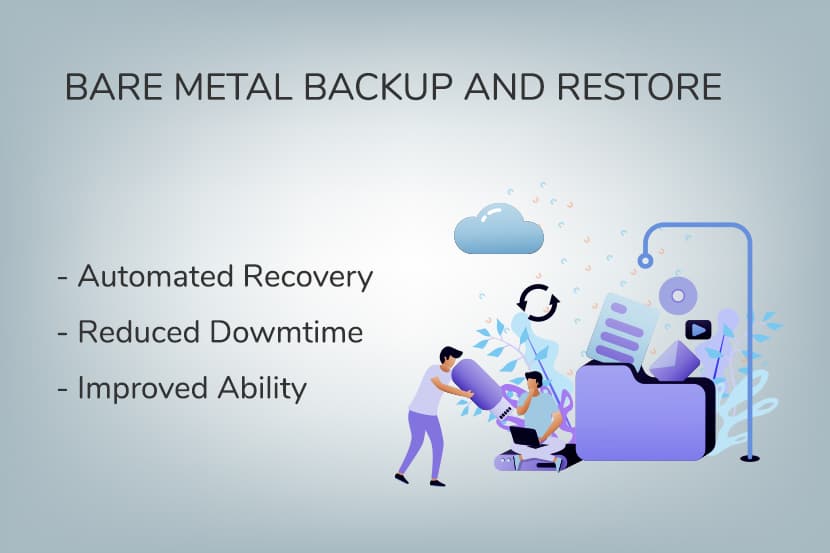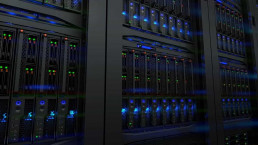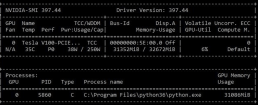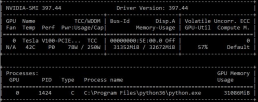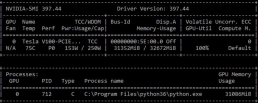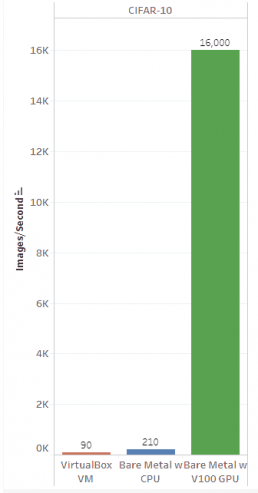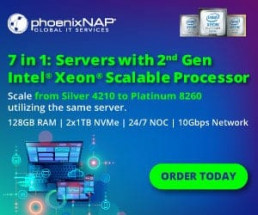What is Quantum Computing & How Does it Work?
Technology giants like Google, IBM, Amazon, and Microsoft are pouring resources into quantum computing. The goal of quantum computing is to create the next generation of computers and overcome classic computing limits.
Despite the progress, there are still unknown areas in this emerging field.
This article is an introduction to the basic concepts of quantum computing. You will learn what quantum computing is and how it works, as well as what sets a quantum device apart from a standard machine.
What is Quantum Computing? Defined
Quantum computing is a new generation of computers based on quantum mechanics, a physics branch that studies atomic and subatomic particles. These supercomputers perform computations at speeds and levels an ordinary computer cannot handle.
These are the main differences between a quantum device and a regular desktop:
- Different architecture: Quantum computers have a different architecture than conventional devices. For example, instead of traditional silicon-based memories or processors, different technology platforms, such as super conducting circuits and trapped atomic ions are utilized.
- Computational intensive use cases: A casual user might not have much use for a quantum computer. The computational-heavy focus and complexity of these machines make them suitable for corporate and scientific settings in the foreseeable future.
Unlike a standard computer, its quantum counterpart can perform multiple operations simultaneously. These machines also store more states per unit of data and operate on more efficient algorithms.
Incredible processing power makes quantum computers capable of solving complex tasks and searching through unsorted data.
What is Quantum Computing Used for? Industry Use Cases
The adoption of more powerful computers benefits every industry. However, some areas already stand out as excellent opportunities for quantum computers to make a mark:
- Healthcare: Quantum computers help develop new drugs at a faster pace. DNA research also benefits greatly from using quantum computing.
- Cybersecurity: Quantum programming can advance data encryption. The new Quantum Key Distribution (QKD) system, for example, uses light signals to detect cyber attacks or network intruders.
- Finance: Companies can optimize their investment portfolios with quantum computers. Improvements in fraud detection and simulation systems are also likely.
- Transport: Quantum computers can lead to progress in traffic planning systems and route optimization.
What are Qubits?
The key behind a quantum computer’s power is its ability to create and manipulate quantum bits, or qubits.
Like the binary bit of 0 and 1 in classic computing, a qubit is the basic building block of quantum computing. Whereas regular bits can either be in the state of 0 or 1, a qubit can also be in the state of both 0 and 1.
Here is the state of a qubit q0:
q0 = a|0> + b|1>, where a2 + b2 = 1
The likelihood of q0 being 0 when measured is a2. The probability of it being 1 when measured is b2. Due to the probabilistic nature, a qubit can be both 0 and 1 at the same time.
For a qubit q0 where a = 1 and b = 0, q0 is equivalent to a classical bit of 0. There is a 100% chance to get to a value of 0 when measured. If a = 0 and b = 1, then q0 is equivalent to a classical bit of 1. Thus, the classical binary bits of 0 and 1 are a subset of qubits.
Now, let’s look at an empty circuit in the IBM Circuit Composer with a single qubit q0 (Figure 1). The “Measurement probabilities” graph shows that the q0 has 100% of being measured as 0. The “Statevector” graph shows the values of a and b, which correspond to the 0 and 1 “computational basis states” column, respectively.
In the case of Figure 1, a is equal to 1 and b to 0. So, q0 has a probability of 12 = 1 to be measured as 0.

A connected group of qubits provides more processing power than the same number of binary bits. The difference in processing is due to two quantum properties: superposition and entanglement.
Superposition in Quantum Computing
When 0 < a and b < 1, the qubit is in a so-called superposition state. In this state, it is possible to jump to either 0 or 1 when measured. The probability of getting to 0 or 1 is defined by a2 and b2.
The Hadamard Gate is the basic gate in quantum computing. The Hadamard Gate moves the qubit from a non-superposition state of 0 or 1 into a superposition state. While in a superposition state, there is a 0.5 probability of it being measured as 0. There is also a 0.5 chance of the qubit ending up as 1.
Let’s look at the effect of adding the Hadamard Gate (shown as a red H) on q0 where q0 is currently in a non-superposition state of 0 (Figure 2). After passing the Hadamard gate, the “Measurement Probabilities” graph shows that there is a 50% chance of getting a 0 or 1 when q0 is measured.

The “Statevector” graph shows the value of a and b, which are both square roots of 0.5 = 0.707. The probability for the qubit to be measured to 0 and 1 is 0.7072 = 0.5, so q0 is now in a superposition state.
What Are Measurements?
When we measure a qubit in a superposition state, the qubit jumps to a non-superposition state. A measurement changes the qubit and forces it out of superposition to the state of either 0 or 1.
If a qubit is in a non-superposition state of 0 or 1, measuring it will not change anything. In that case, the qubit is already in a state of 100% being 0 or 1 when measured.
Let us add a measurement operation into the circuit (Figure 3). We measure q0 after the Hadamard gate and output the value of the measurement to bit 0 (a classical bit) in c1:

To see the results of the q0 measurement after the Hadamard Gate, we send the circuit to run on an actual quantum computer called “ibmq_armonk.” By default, there are 1024 runs of the quantum circuit. The result (Figure 4) shows that about 47.4% of the time, the q0 measurement is 0. The other 52.6% of times, it is measured as 1:
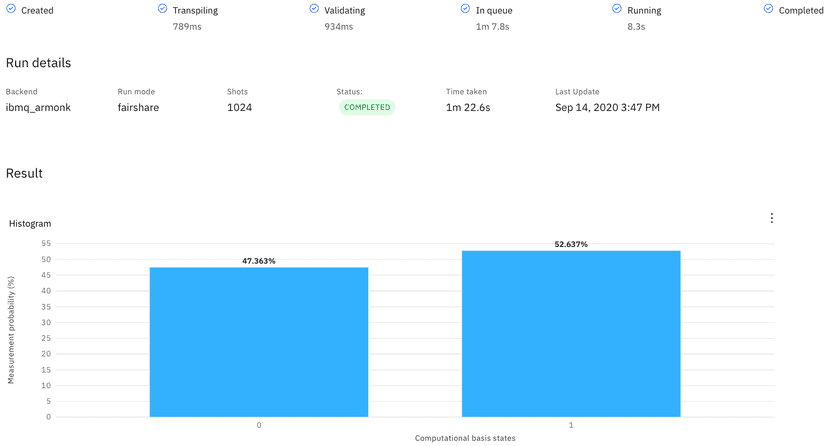
The second run (Figure 5) yields a different distribution of 0 and 1, but still close to the expected 50/50 split:
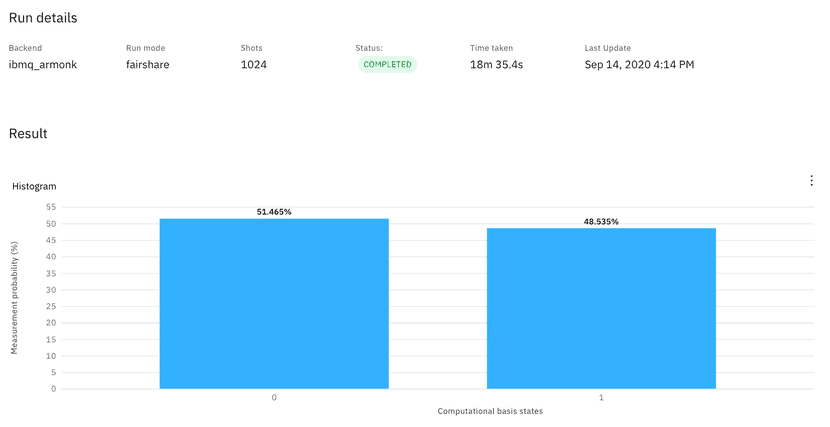
Entanglement in Quantum Computing
If two qubits are in an entanglement state, the measurement of one qubit instantly “collapses” the value of the other. The same effect happens even if the two entangled qubits are far apart.
If we measure a qubit (either 0 or 1) in an entanglement state, we get the value of the other qubit. There is no need to measure the second qubit. If we measure the other qubit after the first one, the probability of getting the expected result is 1.
Let us look at an example. A quantum operation that puts two untangled qubits into an entangled state is the CNOT gate. To demonstrate this, we first add another qubit q1, which is initialized to 0 by default. Before the CNOT gate, the two qubits are untangled, so q0 has a 0.5 chance of being 0 or 1 due to the Hadamard gate, while q1 is going to be 0. The “Measurement Probabilities” graph (Figure 6) shows that the probability of (q1, q0) being (0, 0) or (0, 1) is 50%:
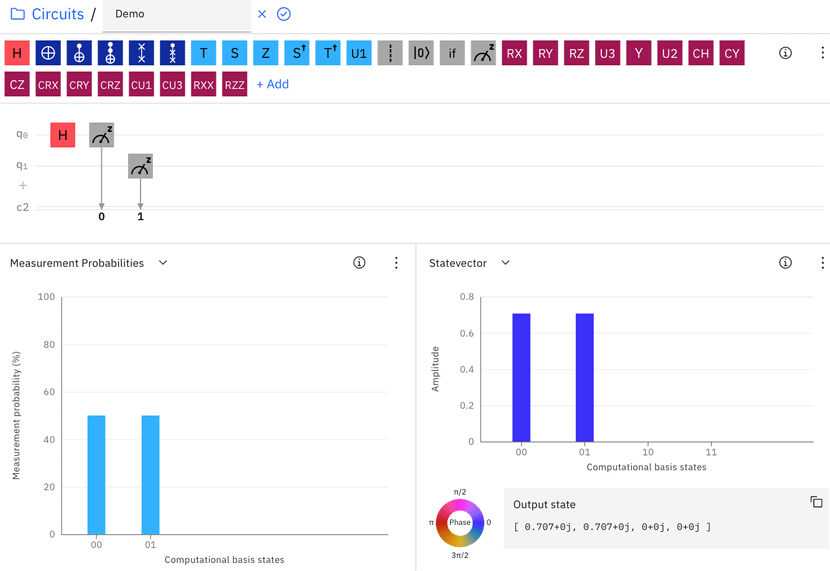
Then we add the CNOT gate (shown as a blue dot and the plus sign) that takes the output of q0 from the Hadamard gate and q1 as inputs. The “Measurement Probabilities” graph now shows that there is a 50% chance of (q1, q0) being (0, 0) and 50% of being (1, 1) when measured (Figure 7):
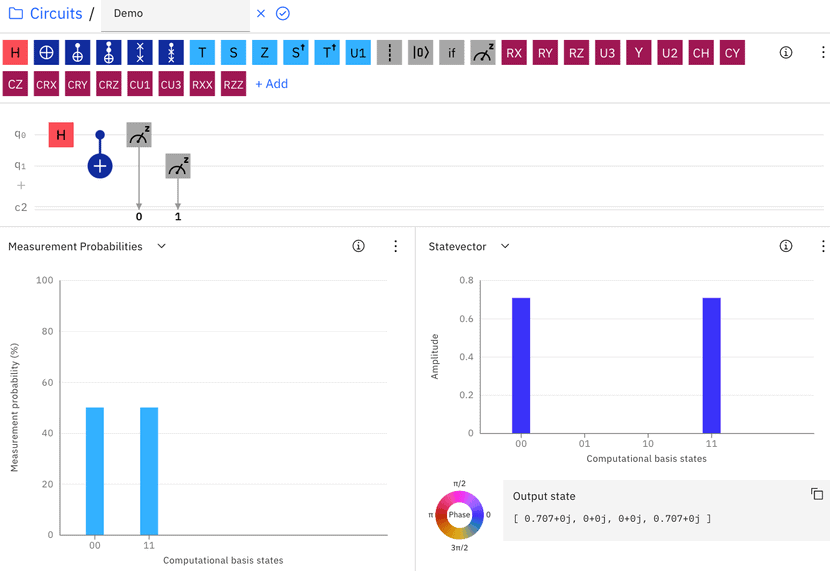
There is zero chance of getting (0, 1) or (1, 0). Once we determine the value of one qubit, we know the other’s value because the two must be equal. In such a state, q0 and q1 are entangled.
Let us run this on an actual quantum computer and see what happens (Figure 8):

We are close to a 50/50 distribution between the ‘00’ and ‘11’ states. We also see unexpected occurrences of ‘01’ and ‘10’ due to the quantum computer’s high error rates. While error rates for classical computers are almost non-existent, high error rates are the main challenge of quantum computing.
The Bell Circuit is Only a Starting Point
The circuit shown in the ‘Entanglement’ section is called the Bell Circuit. Even though it is basic, that circuit shows a few fundamental concepts and properties of quantum computing, namely qubits, superposition, entanglement, and measurements. The Bell Circuit is often cited as the Hello World program for quantum computing.
By now, you probably have many questions, such as:
- How do we physically represent the superposition state of a qubit?
- How do we physically measure a qubit, and why would that force a qubit into 0 or 1?
- What exactly is the |0> and |1> in the formulation of qubit?
- Why do a2 and b2 correspond to the chance of a qubit being measured as 0 and 1?
- What are the mathematical representations of the Hadamard and CNOT gates? Why do gates put qubits into superposition and entanglement states?
- Can we explain the phenomenon of entanglement?
There are no shortcuts to learning quantum computing. The field touches on complex topics spanning physics, mathematics, and computer science.
There is an abundance of good books and video tutorials that introduce the technology. These resources typically cover pre-requisite concepts like linear algebra, quantum mechanics, and binary computing.
In addition to books and tutorials, you can also learn a lot from code examples. Solutions to financial portfolio optimization and vehicle routing, for example, are great starting points for learning about quantum computing.
The Next Step in Computer Evolution
Quantum computers have the potential to exceed even the most advanced supercomputers. Quantum computing can lead to breakthroughs in science, medicine, machine learning, construction, transport, finances, and emergency services.
The promise is apparent, but the technology is still far from being applicable to real-life scenarios. New advances emerge every day, though, so expect quantum computing to cause significant disruptions in years to come.
Recent Posts
Dedicated Server Benefits: 5 Advantages for Your Business
You understand the value of your company’s online presence.
You have your website, but how is it performing? Many business owners do not realize that they share servers with 100’s or even 1000’s of other websites.
Is it time to take your business to the next level and examine the benefits of using dedicated servers.
You may be looking to expand. Your backend database may be straining under the pressure of all those visitors. To stay ahead of competitors, every effort counts.
Your shared server hosting has limitations to your growing business needs. In short, you need a dedicated hosting provider. Whether it’s with shared or dedicated hosting, you get what you pay for.
Let’s address the question that is top of your (or your CFO’s) mind.
How much will a dedicated server cost the business?
The answer to that question depends on the following:
- the computing power you need
- amount of bandwidth you will require
- the quantity of secure data storage and backup
A dedicated server is more expensive than a shared web hosting arrangement, but the benefits are worthy of the increased costs.
Why? A dedicated server supplies more of what you need. It is in a completely different league. Its power helps you level the playing field. You can be more competitive in the growing world of eCommerce.
Five Dedicated Server Benefits
A dedicated server leverages the power and scalability. With a dedicated server, your business realizes a compound return on its monthly investment in the following ways:
1. Exclusive use of dedicated resources
When you have your own dedicated server, you get the entire web server for your exclusive use. This is a significant advantage when comparing shared hosting vs. dedicated hosting.
The server’s disk space, RAM, bandwidth, etc., now belong to you.
- You have exclusive use of all the CPU or RAM and bandwidth. At peak business times, you continue to get peak performance.
- You have root access to the server. You can add your own software and configure settings and access the server logs. Root access is the key advantage of dedicated servers. Again, it goes back to exclusivity.
So, within the limits of propriety, the way you decide to use your dedicated hosting plan is your business.
You can run your applications or implement special server security measures. You can even use a different operating system from your provider. In short, you can drive your website the way you drive your business—in a flexible, scalable, and responsive way.
2. Flexibility managing your growing business
A dedicated server can accommodate your growing business needs. With a dedicated server, you can decide on your own server configuration. As your business grows, you can add more or modify existing services and applications. You remain more flexible when new opportunities arise or unexpected markets materialize.
It is scalability for customizing to your needs. If you need more processing, storage, or backup, the dedicated server is your platform.
Also, today’s consumers have higher expectations. They want the convenience of quick access to your products. A dedicated server serves your customers with fast page loading and better user experience. If you serve them, they will return.
3. Improved reliability and performance
Reliability is one of the benefits of exclusivity. A dedicated server provides peak performance and reliability.
That reliability also means that server crashes are far less likely. Your website has extra resources during periods of high-volume traffic. If your front end includes videos and image displays, you have the bandwidth you need. Second, only to good website design are speed and performance. The power of a dedicated server contributes to the optimum customer experience.
Managed dedicated web hosting is a powerful solution for businesses. It comes with a higher cost than shared hosting. But you get high power, storage, and bandwidth to host your business.
A dedicated server provides a fast foothold on the web without upfront capital expenses. You have exclusive use of the server, and it is yours alone. Don’t overlook technical assistance advantages. You or your IT teams oversee your website.
Despite that vigilance, sometimes you need outside help. Many dedicated hosting solutions come with equally watchful technicians. With managed hosting, someone at the server end is available for troubleshooting around the clock.
4. Security through data separation
Dedicated servers permit access only to your company.
The server infrastructure includes firewalls and security monitoring.
This means greater security against:
- Malware and hacks: The host’s network monitoring, secure firewalls, and strict access control free you to concentrate on your core business.
- Preventing denial of service attacks: Data separation isolates your dedicated server from the hosting company’s services and data belonging to other customers. That separation ensures quick recovery from backend exploits.
You can also implement your own higher levels of security. You can install your applications to run on the server. Those applications can include new layers of security and access control.
This adds a level of protection to your customer and proprietary business data. You safeguard your customer and business data, again, through separation.
5. No capital or upfront expense
Upfront capital expense outlays are no longer the best way to finance technology. Technology advances outpace their supporting platforms in a game of expensive leapfrog. Growing businesses need to reserve capital for other areas.
Hosting providers provide reasonable fees while providing top of the line equipment.
A dedicated hosting provider company can serve many clients. The cost of that service is a fraction of what you would pay to do it in-house. Plus you the bonuses of physical security and technical support.
What to Consider When Evaluating Dedicated Server Providers
Overall value
Everyone has a budget, and it’s essential to choose a provider that fits within that budget. However, price should not be the first or only consideration. Many times, it can end up costing you more in the long run by simply choosing the lowest priced option. Take a close look at what the provider offers in the other six categories we’ll cover in this guide, and then ask yourself if the overall value aligns with the price you’ll pay to run the reliable business you strive for.
Reputation
What are other people and businesses saying about a provider? Is it good, bad, or is there nothing at all? A great way to know if a provider is reliable and worthy of your business is to learn from others’ experiences. Websites like Webhostingtalk.com provide a community where others are talking about hosting and hosting related topics. One way to help decide on a provider is to ask the community for feedback. Of course, you can do some due diligence ahead of time by simply searching the provider’s name in the search function.
Reliability
Businesses today demand to be online and available to their customers 24 hours a day, seven days a week, and 365 days a year. Anything less means you’re probably losing money. Sure, choosing the lowest priced hosting probably seems like a good idea at first, but you have to ask yourself is the few dollars you save per month worth the headache and lost revenue if your website is offline. The answer is generally no.
Support
You only need it, when you need it. Even if you’re administering your own server, having reliable, 24×7 support available when you need it is critical. The last thing you want is to have a hard time reaching someone when you need them most. Look for service providers that offer multiple support channels such as live chat, email, and phone.
Service level agreements
SLA’s are the promises your provider is making to you in exchange for your payment(s). With the competitiveness of the hosting market today, you shouldn’t choose a provider that doesn’t offer important Service Level Agreements such as uptime, support response times, hardware replacement, and deployment times.
Flexibility
Businesses go through several phases of their lifecycle. It’s important to find a provider that can meet each phase’s needs and allow you to quickly scale up or down based on your needs at any given time. Whether you’re getting ready to launch and need to keep your costs low, or are a mature business looking to expand into new areas, a flexible provider that can meet these needs will allow you to focus on your business and not worry about finding someone to solve your infrastructure headaches.
Hardware quality
Business applications demand 24×7 environments and therefore need to run on hardware that can support those demands. It’s important to make sure that the provider you select offers server-grade hardware, not desktop-grade, which is built for only 40 hour work weeks. The last thing you want is for components to start failing, causing your services to be unavailable to your customers.
Advantages of Dedicated Servers, Ready to Make the Move?
Dedicated hosting provides flexibility, scalability, and better management of your own and your customers’ growth. They also offer reliability and peak performance which ensures the best customer experience.
Include the option of on-call, around-the-clock server maintenance, and you have found the hosting solution your business is looking for.
Recent Posts
Comprehensive Guide to Intelligent Platform Management Interface (IPMI)
Intelligent Platform Management Interface (IPMI) is one of the most used acronyms in server management. IPMI became popular due to its acceptance as a standard monitoring interface by hardware vendors and developers.
So what is IPMI?
The short answer is that it is a hardware-based solution used for securing, controlling, and managing servers. The comprehensive answer is what this post provides.
What is IPMI Used For?
IPMI refers to a set of computer interface specifications used for out-of-band management. Out-of-band refers to accessing computer systems without having to be in the same room as the system’s physical assets. IPMI supports remote monitoring and does not need permission from the computer’s operating system.
IPMI runs on separate hardware attached to a motherboard or server. This separate hardware is the Baseboard Management Controller (BMC). The BMC acts like an intelligent middleman. BMC manages the interface between platform hardware and system management software. The BMC receives reports from sensors within a system and acts on these reports. With these reports, IPMI ensures the system functions at its optimal capacity.
IPMI collaborates with standard specification sets such as the Intelligent Platform Management Bus (IPMB) and the Intelligent Chassis Management Bus (ICMB). These specifications work hand-in-hand to handle system monitoring tasks.
Alongside these standard specification sets, IPMI monitors vital parameters that define the working status of a server’s hardware. IPMI monitors power supply, fan speed, server health, security details, and the state of operating systems.
You can compare the services IPMI provides to the automobile on-board diagnostic tool your vehicle technician uses. With an on-board diagnostic tool, a vehicle’s computer system can be monitored even with its engine switched off.
Use the IPMItool utility for managing IPMI devices. For instructions and IPMItool commands, refer to our guide on how to install IPMItool on Ubuntu or CentOS.
Features and Components of Intelligent Platform Management Interface
IPMI is a vendor-neutral standard specification for server monitoring. It comes with the following features which help with server monitoring:
- A Baseboard Management Controller – This is the micro-controller component central to the functions of an IPMI.
- Intelligent Chassis Management Bus – An interface protocol that supports communication across chasses.
- Intelligent Platform Management Bus – A communication protocol that facilitates communication between controllers.
- IPMI Memory – The memory is a repository for an IPMI sensor’s data records and system event logs.
- Authentication Features – This supports the process of authenticating users and establishing sessions.
- Communications Interfaces – These interfaces define how IPMI messages send. IPMI send messages via a direct-out-of-band local-area Networks or a sideband local-area network. IPMI communicate through virtual local-area networks.
Comparing IPMI Versions 1.5 & 2.0
The three major versions of IPMI include the first version released in 1998, v1.0, v1.5, and v2.0. Today, both v1.5 and v2.0 are still in use, and they come with different features that define their capabilities.
Starting with v1.5, its features include:
- Alert policies
- Serial messaging and alerting
- LAN messaging and alerting
- Platform event filtering
- Updated sensors and event types not available in v1. 0
- Extended BMC messaging in channel mode.
The updated version, v2.0, comes with added updates which include:
- Firmware Firewall
- Serial over LAN
- VLAN support
- Encryption support
- Enhanced authentication
- SMBus system interface
Analyzing the Benefits of IPMI
IPMI’s ability to manage many machines in different physical locations is its primary value proposition. The option of monitoring and managing systems independent of a machine’s operating system is one significant benefit other monitoring tools lack. Other important benefits include:
Predictive Monitoring – Unexpected server failures lead to downtime. Downtime stalls an enterprise’s operations and could cost $250,000 per hour. IPMI tracks the status of a server and provides advanced warnings about possible system failures. IPMI monitors predefined thresholds and provides alerts when exceeded. Thus, actionable intelligence IPMI provides help with reducing downtime.
Independent, Intelligent Recovery – When system failures occur, IPMI recovers operations to get them back on track. Unlike other server monitoring tools and software, IPMI is always accessible and facilitates server recoveries. IPMI can help with recovery in situations where the server is off.
Vendor-neutral Universal Support – IPMI does not rely on any proprietary hardware. Most hardware vendors integrate support for IPMI, which eliminates compatibility issues. IPMI delivers its server monitoring capabilities in ecosystems with hardware from different vendors.
Agent-less Management – IPMI does not rely on an agent to manage a server’s operating system. With it, making adjustments to settings such as BIOS without having to log in or seek permission from the server’s OS is possible.
The Risks and Disadvantages of IPMI
Using IPMI comes with its risks and a few disadvantages. These disadvantages center on security and usability. User experiences have shown the weaknesses include:
Cybersecurity Challenges – IPMI communication protocols sometimes leave loopholes that can be exploited by cyber-attacks, and successful breaches are expensive as statistics show. The IPMI installation and configuration procedures used can also leave a dedicated server vulnerable and open to exploitation. These security challenges led to the addition of encryption and firmware firewall features in IPMI version 2.0.
Configuration Challenges – The task of configuring IPMI may be challenging in situations where older network settings are skewed. In cases like this, clearing network configuration through a system’s BIOS is capable of solving the configuration challenges encountered.
Updating Challenges – The installation of update patches may sometimes lead to network failure. Switching ports on the motherboard may cause malfunctions to occur. In these situations, rebooting the system is capable of solving the issue that caused the network to fail.
Server Monitoring & Management Made Easy
Intelligent Platform Management brings ease and versatility to the task of server monitoring and management. By 2022, experts expect the IPMI market to hit the $3 billion mark. PheonixNAP bare metal servers come with IPMI, and it gives you access to the IPMI of every server you use. Get started by signing up today.
Recent Posts
17 Best Server Monitoring Software & Tools for 2020
The adoption of cloud technologies has made setting up and managing large numbers of servers for business and application needs quite convenient. Organizations opt for high amounts of servers to satisfy load balancing needs and also to cater to situations like disaster recovery.
Given these trends, server monitoring tools have become extremely important. While there are many types of server management tools, they cater to different aspects of monitoring servers. We looked at 17 of the best software tools for monitoring servers in this article.
Best Monitoring Tools for Servers
1. Nagios XI
A list of tools server monitoring software, would not be complete without Nagios. It’s a reliable tool to monitor server health. This Linux based monitoring system provides real-time monitoring of operating systems, applications, infrastructure performance monitoring, and systems metrics.
A variety of third-party plugins makes Nagios XI able to monitor all types of in-house applications. Nagios is equipped with a robust monitoring engine and an updated web interface to facilitate excellent monitoring capabilities through visualizations such as graphs.
Getting a central view of your server and network operations is the main benefit of Nagios. Nagios Core is available as a free monitoring system. Nagios XI comes recommended due to its advanced monitoring, reporting, and configuration options.
2. WhatsUp Gold
WhatsUp Gold is a well-established monitoring tool for Windows servers. Due to its robust layer 2/3 discovery capabilities, WhatsUp Gold can create detailed interactive maps of the entire networked infrastructure. It can monitor web servers, applications, virtual machines, and traffic flow across Windows, Java, and LAMP environments.
It provides real-time alerts via email and SMS in addition to the monitoring and management capabilities offered in the integrated mobile application. The integrated REST API’s features include capabilities such as integrating monitoring data with other applications and automating many tasks.
WhatsUp Gold provides specific monitoring solutions for AWS, Azure, and SQL Server environments. These integrate with native interfaces and collect data regarding availability, cost, and many other environment-specific metrics.
3. Zabbix
Zabbix is a free and open-source Linux server monitoring tool. It is an enterprise-level monitoring solution and facilitates monitoring servers, networks, cloud services, applications, and services. One of its most significant advantages is the ability to configure directly from the web interface, rather than having to manage text files like on some other tools like Nagios.
Zabbix provides a multitude of metrics like CPU usage, free disk space, temperature, fan state, and network status in its network management software. Also, it provides ready-made templates for popular servers like HP, IBM, Lenovo, Dell, and operating systems such as Linux, Ubuntu, and Solaris.
The monitoring capabilities of Zabbix are enhanced even more through the possibility of setting complex triggers and dependencies for data collection and alerting.
4. Datadog
Datadog is a consolidated monitoring platform for your servers, applications, and stacks. Named a leader in intelligent application and server monitoring in 2019 by Forrester Wave, Datadog boasts of a centralized dashboard that brings many metrics together.
Datadog’s monitoring features include those required for servers and into the realm of source control and bug tracking as well. It also facilitates many metrics, such as traffic by source and containers in cloud-native environments. Notifications are available by email, Slack, and many other channels.
Mapping dependencies and application architecture across teams has allowed users of Datadog to build a complete understanding of how applications and data flow work across large environments.
5. SolarWinds Server and Application Monitor
SolarWinds monitors your server infrastructure, applications, databases, and security. Its Systems Management Software provides monitoring solutions for servers, virtualization, disk space, server configurations, and backups.
The main advantage here is that SolarWinds Server and Application Monitor allows getting started within minutes thanks to their vast number of (1,200+) pre-defined templates for many types of servers and cloud services. These templates can quickly be customized to suit virtually any kind of setup.
SolarWinds application monitoring boasts a comprehensive system for virtual servers across on-premise, cloud, and hybrid environments to overcome VM Sprawl and having to switch to different tools. Tools are available for capacity planning, event monitoring, and data analysis with alerts and dashboards.
6. Paessler PRTG
Paessler Router Traffic Grapher is a server management software that uses SNMP, Packet Sniffing, and Netflow. PRTG caters to both Windows servers and Linux environments. A wide range of server monitoring software applications is available for services, network, cloud, databases, and applications.
The PTRG server monitoring solution caters to web servers, database servers, mail, and virtual servers. Cloud monitoring is the strong suit of PTRG, providing a centralized monitoring system for all types of IAAS / SAAS / PAAS solutions such as Amazon, Docker, and Azure.
PTRG monitors firewalls and IPs to ensure inbound and outbound traffic. It will provide regular updates regarding firewall status and automatic notifications through the integrated web and mobile applications continually monitoring your network security.
7. OpenNMS
OpenNMS is a fully open-source server monitoring solution published under the AGPLv3 license. It is built for scalability and can monitor millions of devices from a single instance.
It has a flexible and extensible architecture that supports extending service polling and performance data collection frameworks. OpenNMS is supported both by a large community and commercially by the OpenNMS group.
OpenNMS brings together the monitoring of many types of servers and environments by normalizing specific messages and disseminating them through a powerful REST API. Notifications are available via email, Slack, Jabber, Tweets, and the Java native notification strategy API. OpenNMS also provides ticketing integrations to RT, JIRA, OTRS, and many others.
8. Retrace
Retrace includes robust monitoring capabilities and is highly scalable. It is recommended for new teams without much experience as it provides smart defaults based on your environment. This program gives you a headstart in monitoring servers and applications.
It monitors application performance, error tracking, log management, and application metrics. Retrace notifies relevant users via SMS, email, and Slack alerts based on multiple monitoring thresholds and notifications groups.
Custom dashboards allow Retrace to provide both holistic and granular data regarding server health. These dashboard widgets collect data on CPU usage, disk space, network utilization, and uptime. Retrace supports both Windows servers as well as Linux.
9. Spiceworks Network Monitor
Spiceworks is a simplified free server monitoring software for server and network monitoring. The connectivity dashboard can be set up on any server in minutes, and after application URL configuration, monitoring can begin immediately.
You will be able to receive real-time insights regarding slow network connections and overloaded applications, both on-premise as well as on the cloud. You will be able to fix issues before they become problematic. One disadvantage is that there is no proper mechanism for notifications. Spiceworks has promised a solution to this soon through email alerts for server and application events.
The monitoring solution is fully integrated with the Spiceworks IT management cloud tools suite and also provides free support through online chat and phone.
10. vRealize Hyperic
An open-source tool for server and network monitoring from VMware, vRealize Hyperic provides monitoring solutions for a wide range of operating systems. Including middleware and applications in both physical and virtual environments.
Infrastructure and OS application monitoring tools allow users to understand availability, utilization, events, and changes across every layer of your virtualization stack, from the vSphere hypervisor to guest OSs.
Middleware monitors collect data of thousands of metrics useful for application performance monitoring. The vRealize Operations Manager application provides centralized monitoring for infrastructure, middleware, and applications.
11. Icinga
Icinga has a simple set of goals, monitor availability, provide access to relevant data, and raise alerts to keep users informed promptly. The integrated monitoring engine is capable of monitoring large environments, including data centers.
The fast web interface gives you access to all relevant data. Users will be able to build custom views by grouping and filtering individual elements and combining them in custom dashboards. This setup allows you to take quick action to resolve any issues it’s identified.
Notifications arrive via email, SMS, and integrated web and mobile applications. Icinga is fully integrated with VMware environments and fetches data about hosts, virtual servers, databases, and many other metrics and displays them on a clean dashboard.
12. Instrumental
Instrumental is a clean and intuitive application that monitors your server and applications. It provides monitoring capabilities across many platforms such as AWS and Docker, many database types, and applications stacks such as .Net, Java, Node.js, PHP, Python, and Ruby.
In addition to the native methods available to collect data, Instrumental also integrates with many other platforms like Statiste, telegraf, and StatsD. The built-in query language allows you to transform, aggregate, and time-shift data to suit any visualization you require.
A purposefully designed dashboard interface allows viewing holistic data as well as digging deep into each server and application. Instrumental provides configurable alerts via email, SMS, and HTTP notification based on changes to metrics.
13. Tornimo
Tornimo brings real-time monitoring with unlimited scaling. It is a Graphite compatible application monitoring platform with a front end build on Grafana dashboards. It also provides support for switching from a custom Graphite deployment or many other compatible SaaS platforms in minutes.
Tornimo uses a proprietary database system that allows it to handle up to a million metrics as your environment grows. Clients trust Tornimo to monitor mission-critical systems irrespective of the amount of data they need to monitor as it offers consistent response times.
A significant advantage of Tornimo over many other monitoring tools is that it does not average older data to save on storage. It allows users to leverage older data to identify anomalies with ease.
14. ManageEngine OpManager
OpManager from ManageEngine is a trusted server monitoring software that has robust monitoring capabilities for all types of network nodes such as routers and switches, servers, VMs, and almost anything that has an IP.
With over 2,000 built-in server performance monitoring tools, OpManager’s monitoring tools for servers cater to both physical and virtual servers with multi-level thresholds and instant alerts. It provides customizable dashboards to monitor your network at a glance.
As a server monitoring solution for Windows, Linux, Solaris, and Unix, OpManager supports system health monitoring and process monitoring through SNMP and WMI for many platforms such as VMware, Hyper-V, and Citrix XenServer.
15. Sciencelogic SL1
The server management tools from Sciencelogic allow you to monitor all your server and network resources based on their configurations, performance, utilization, and capacity spanning across a multitude of vendors and server technologies.
Supported platforms include cloud services such as AWS, Azure, Google Cloud, and OpenStack. Sciencelogic also supports Hypervisors like VMware, Hyper-V, Xen, and KVM as well as containers like Docker. In terms of operating systems, it supports Windows, Unix, and Linux.
Sciencelogic’s custom dashboards allow monitoring through ready-made or custom monitoring policies, using health checks and ticket queues associated with pre-defined events. It uses advanced API connectivity to merge with cloud services and provide accurate data for monitoring.
16. Panopta
Panopta facilitates server and network monitoring for on-premise, cloud, and hybrid servers. Panopta provides a unified view across all your server environments through server agents and native cloud platform integrations.
A comprehensive library of out-of-the-box metrics makes setting up Panopta quick and convenient. You can configure these via reporting features and customizable dashboards for a clear, holistic view. It avoids alert fatigue and false positives by filtering through accurate and actionable information.
CounterMeasures is a tool offered by Panopta to configure pre-defined remedial actions to resolve recurring issues as they are detected. Panopta’s SaaS-delivered monitoring platform allows organizations to have a single point for monitoring all its infrastructure without any additional equipment or worrying about which OS they use and licenses.
17. Monitis
Monitis is a simplified monitoring tool for servers, applications, and more with a simple sign-up process and no software to be set up. A unified dashboard provides data on uptime and response time, server health, and many other custom metrics.
Instant alerts are supported via email, SMS, Twitter, and phone when any of the pre-defined triggers are activated. Monitis supports alerts even when your network is down. It also provides an API for additional monitoring needs so that users can import metrics and data to external applications.
Monitis provides monitoring capabilities along with reporting that users can share. Users can access these features through both the web interface as well as the integrated mobile applications.
Choosing Server Monitoring Software
The top server monitoring tools we listed have one goal in common – to monitor the uptime and health of your servers and applications. Most of these tools offer free trials or free versions with limited functionality, so make sure to try them out before selecting the best server monitoring tool for your servers.
Looking for application performance monitoring tools, then read our guide on the 7 Best Website Speed and Performance Testing Tools.
If you would like to learn more, bookmark our blog and follow the latest developments on servers, container technology, and many other cloud-related topics.
Recent Posts
CentOS vs Ubuntu: Choose the Best OS for Your Web Server
Don’t know whether to use CentOS or Ubuntu for your server? Let’s compare both and decide which one you should use on your server/VPS. In highlighting the two principal Linux distributions’ strengths and weaknesses for running a web server, the choice should become clear.
Linux is an open-source operating system currently powering most of the Internet. There are hundreds of different versions of Linux. For web servers, the two most popular versions are Ubuntu and CentOS. Both are open-source and free community-supported operating systems. You’ll be happy to know these distributions have a ton of community support and, therefore, regularly available updates.
Unlike Windows, Linux’s open-source license and encourages users to experiment with the code. This flexibility has created loyal online communities dedicated to building and improving the core Linux operating system.
Quick Overview of Ubuntu and CentOS
Ubuntu
Ubuntu is a Linux distribution based on Debian Linux. The word Ubuntu comes from the Nguni Bantu language, and it generally means “I am what I am because of who we all are.” It represents Ubuntu’s guiding philosophy of helping people come together in the community. Canonical, the Ubuntu developers, sought to make a Linux OS that was easy to use and had excellent community support.
Ubuntu boasts a robust application repository. It is updated frequently and is designed to be intuitive and easy to use. It is also highly customizable, from the graphical interface down to web server packages and internet security.
CentOS
CentOS is a Linux distribution based on Red Hat Enterprise Linux (RHEL). The name CentOS is an acronym for Community Enterprise Operating System. Red Hat Linux has been a stable and reliable distribution since the early days of Linux. It’s been mostly implemented in high-end corporate IT applications. CentOS continues the tradition started by Red Hat, providing an extremely stable and thoroughly-tested operating system.
Like Ubuntu, CentOS is highly customizable and stable. Due to its early dominance, many conventions are built around the CentOS architecture. Cutting-edge corporate security measures were implemented in RHEL, that quickly adapt to CentOS’s architecture.
Comparing the Features of CentOS and Ubuntu Servers
One key feature for CentOS and Ubuntu is that they are both free. You can download a copy for no charge and install it on your own cheap dedicated server.
Each version can be distributed or downloaded to a USB drive, which you can boot into without making permanent changes to your operating system. A bootable drive allows you to take the system for a test run before you install it.
Basic architecture
CentOS is based on the Red Hat Enterprise Linux architecture, while Ubuntu is based on Debian. This is important when looking at software package management systems. Both versions use a package manager to resolve dependencies, perform installations, and track updates.
Ubuntu uses the apt package manager and installs software from .deb packages. CentOS uses the yum package manager and installs .rpm packages. They both work about the same, but .deb packages cannot be installed on CentOS – and vice-versa.
The difference is in the availability of packages for both systems. Some packages will not be available as efficiently on Ubuntu as they are on CentOS. When working with your developers, find out their preference as they usually tend to stick to just one package type (.deb or .rpm)
Another detail is the structure of individual software packages. When installing Apache, one of the leading web server packages, the service works a little differently in Ubuntu than in CentOS. The Apache service in Ubuntu is labeled apache2, while the same service in CentOS is labeled httpd.
Software
If you’re strictly going by the number of packages, Ubuntu has a definitive edge. The Ubuntu repository lists tens of thousands of individual software packages available for installation. CentOS only lists a few thousand. If you go by the number of packages, Ubuntu would clearly win.
The other side of this argument is that many graphical server tools like cPanel are written solely for Red-Hat-based systems. While there are similar tools in Ubuntu, some of the most widely-used tools in the industry are only available in CentOS.
Stability, security, and updates
Ubuntu is updated frequently. A new version is released every six months. Ubuntu offers LTS (Long-Term Support) versions every two years, which are supported for five years. These different releases allow users to choose whether they want the “latest and greatest” or the “tried-and-true.” Because of the frequent updates, Ubuntu often includes newer software into newer releases. That can be fun for playing with new options and technology, but it can also create conflicts with existing software and configurations.
CentOS is updated infrequently in part because the developer team for CentOS is smaller. It’s also due to the extensive testing on each component before release. CentOS versions are supported for ten years from the date of release and include security and compatibility updates. However, the slow release cycle means a lack of access to third-party software updates. You may need to manually install third-party software or updates if they haven’t made it into the repository. CentOS is reliable and stable. As the core operating system, it is relatively small and lightweight compared to its Windows counterpart. This helps improve speed and lowers the size that the operating system takes up on the hard disk.
Both CentOS and Ubuntu are stable and secure, with patches released regularly.
Support and troubleshooting
If something goes wrong, you’ll want to have a support path. Ubuntu has paid support options, like many enterprise IT companies. One additional advantage, though, is that there are many expert users in the Ubuntu forums. It’s usually easy to find a solution to common errors or problems.
With a new release coming out every six months, it’s not feasible to offer full support for every version. Regular releases are supported for nine months from the release date. Regular users will probably upgrade to the newest versions as they are released.
Ubuntu also releases LTS or Long-Term Support versions. These are supported for a full five years from the installation date. Releases have ongoing patches and updates, so you can keep an LTS release installed (without needing to upgrade) for five years.
Third-party providers often manage centos support. It provides excellent documentation, plus forums and developer blogs that can help you resolve an error. In part, CentOS relies on its community of Red Hat users to know and manage problems.
The CentOS Project is open-source and designed to be freely available. If you need paid support, it’s recommended that you consider paying for Red Hat Enterprise licensing and support. Where CentOS shines is in its dedication to helping its customers. A CentOS operating system is supported for ten years from the date of release.
New operating system releases are published every two years. This frequency can lower the total cost of ownership since you can stretch a single operating system cycle for a full decade. Above, ‘support’ refers both to the ability to get help from developers and the developers’ commitment to patching and updating software.
Ease of use
Ubuntu has gone to great lengths to make its system user-friendly. An Ubuntu server is more focused on usability. The graphical interface is intuitive and easy to manage, with a handy search function. Running utilities from the command-line is straightforward. Most commands will suggest the proper usage, and the sudo command is easy to use to resolve “Access denied” errors.
Where CentOS has some help and community support, Ubuntu has a solid support knowledge base. This support includes both how-to guides and tutorials, as well as an active community forum.
Ubuntu uses the apt-get package manager, which uses a different syntax from yum. But functions are about the same. Many of the applications that CentOS server use, such as cPanel, have similar alternatives available for Ubuntu. Finally, Ubuntu Linux offers a more seamless software installation process. You can still tinker under the hood, but the most commonly-used software and operating system features are included and updated automatically.
Ubuntu’s regular updates can be a liability. They can conflict with your existing software configuration. It’s not always a good thing to use the latest technology. Sometimes it’s better to let someone else work out the bugs before you install an update.
CentOS is typically for more advanced users. One flaw with CentOS is a steep learning curve. There are fewer how-to guides and community forums available if you run into a problem.
There seems to be less hand-holding in CentOS – most guides presume that you know the basics, like sudo or basic command-line features. These are skills you can learn working with other Red Hat professionals or by taking certifications.
With CentOS built around the Red Hat architecture, many old-school Linux users find it more familiar and comfortable. CentOS is also used widely across the Internet at the server level, so using it can improve cross-compatibility. Many CentOS server utilities, such as cPanel, are built to work only in Red Hat Linux.
CentOS or Ubuntu for Development
CentOS takes longer for the developers to test and approve updates. That’s why CentOS releases updates much slower than other Linux variants. If you have a strong business need for stability or your environment is not very tolerant of change, this can be more helpful than a faster release schedule.
Due to the lower and slower support for CentOS, some software updates are not applied automatically. A newer version of a software application may be released but may not make it into the official repository. If this happens, it can leave you responsible for manually checking and installing security updates. Less-experienced users might find this process too challenging.
Ubuntu, as an “out-of-the-box” operating system, includes many different features. There are three different versions of Ubuntu:
- Desktop version, which is for basic end-users;
- Server, web hosting over the Internet or in the cloud
- Core, which is for other devices (like cars, smart TV’s, etc.)
A basic installation of Ubuntu Server should include most of the applications you need to configure your server to host files over a network. It also adds extra software. Such as an open-source office productivity software, as well as the latest kernel and operating system features.
Ubuntu’s focus on features and usability relies on the release of new versions every six months. This is very helpful if you prefer to use the latest software available. These updates can also become a liability if you have custom software that doesn’t play nicely with newer updates.
Cloud deployment
Ubuntu offers excellent support for container virtualizations. It provides support for cloud deployment and expands its influence in the market compared to CentOS. Since June 2019, “Canonical announced full enterprise support for Kubernetes 1.15 kubeadm deployments, its Charmed Kubernetes, and MicroK8s; the popular single-node deployment of Kubernetes. “
CentOS is not being left behind and competes by offering three private cloud choices. It also provides a public cloud platform through AWS. CentOS has a high standard of documentation and provides its users with a mature platform so that CentOS users can apply its features further.
Gaming Servers
Unbuntu has a pack that custom-designed for gamers called the Ubuntu GamePack. It’s based on Ubuntu. It does not come with games preinstalled. It instead comes preinstalled with the PlayOnLinux, Wine, Lutric, and Steam client. It’s a like software intersection where games on Windows, Linux, Console, and Steam are played.
It’s a hybrid version of the Ubuntu OS since it also supports Adobe Flash and Oracle Java. It allows for the seamless play of online gaming. Ubuntu gamepack is optimized for over six thousand Windows and Linux games, which guaranteed launch and function in the Ubuntu GamePack. If you’ve more familiar with Ubuntu, then choose the desktop version for gaming.
CentOS is not as popular for gaming as Ubuntu. If you’ve used CentOS for your server, then you can try the Fedora-based distribution for gaming. It’s called Fedora Games Spin, and it’s the preferred Linux distribution for gaming servers for CentOS/RedHat/Fedora Linux users.
Most of the best gaming distros are Debian/Ubuntu-based, but if you’re committed to CentOS, you can run it in live mode from a USB/DVD media without installing it. It’s accompanied by an Xfce desktop environment and has over two thousand Linux games. It’s a single platform that allows you to play all Fedora games.
Comparison Table of CentOS and Ubuntu Linux Versions |
||
| Features | CentOS | Ubuntu |
| Security | Strong | Good (needs further configuration) |
| Support Considerations | Solid documentation. Active but limited user community. | High-level documentation and large support community |
| Update Cycle | Infrequent | Often |
| System Core | Based on Redhat | Based on Debian |
| Cloud Interface | CloudStack, OpenStack, OpenNebula | OpenStack |
| Virtualization | Native KVM Support | Xen, KVM |
| Stability | High | Solid |
| Package Management | YUM | aptitude, apt-get |
| Platform Focal Point | Targets server market, choice of larger corporations | Targets desktop users |
| Speed Considerations | Excellent (depending on hardware) | Excellent (depending on hardware) |
| File Structure | Identical file/folder structure, system services differ by location | Identical file/folder structure, system services differ by location |
| Ease of Use | Difficult/Expert Level | Moderate/User-friendly |
| Manageability | Difficult/Expert Level | Moderate/User-friendly |
| Default applications | Updates as required | Regularly updated |
| Hosting Market Share | 497,233 sites – 17.5% of Linux users | 772,127 sites – 38.2% of Linux users |
Bottom Line on Choosing a Linux Distribution for Your Server
Both CentOS and Ubuntu are free to use. Your decision should reflect the needs of your web server and usage.
If you’re more of a beginner in being a server admin, you might lean towards Ubuntu. If you’re a seasoned pro, CentOS might be more appealing. If you like implementing new software and technology as it’s released, Ubuntu might hold the edge for you. If you hate dealing with updates breaking your server, CentOS might be a better fit. Either way, you shouldn’t worry about one being better than the other.
Both are approximately equal in security, stability, and functionality – Let us help you choose the system that will serve your business best.
Shared Hosting vs Dedicated Hosting: Make an Informed Choice
Every provider claims to put unlimited scalability at your disposal, but is that truly the case? In today’s hosting market, it is difficult to tell the difference between a shared and dedicated hosting. Especially mid-sized businesses need to make tough decisions. Most require dedicated resources, but often lack expertise, so both shared and dedicated seem like viable options.
This article considers both options, learn the critical difference between dedicated and shared web hosting.
What is Shared Hosting?
As the name implies, shared hosting means you are sharing a physical server with other tenants. That includes all physical resources such as hard drive, CPU power, memory usage, and bandwidth.
A hypervisor layer segments the server, and each tenant has access to their own isolated virtual environment. You have limited customization options, and the provider manages the environment. It is a more affordable option compared to dedicated hosting.
Below are some of the key characteristics of shared hosting.
Limited Hosting Resources
No matter what providers say, shared hosting always provides limited hosting resources. To be more precise, scaling up is ever a problem with shared hosting. Every small and medium-sized business desires to grow. Their IT resources should facilitate or at least go hand in hand with that growth. Whether that is possible with limited shared plans depends on your type of business and individual use case. Generally, shared hosting may only be scaled up to provide more bandwidth and storage.
Note: Scalability is the room to expand your resources, such as bandwidth, drive space, processing power, etc. It is also the ability to install custom software. Scalability provides room to accommodate for different use cases.
Latency
Shared hosting involves multiple virtualized environments, so it is more prone to suffer from high latency. There is a hypervisor layer between your environment and the underlying bare metal server. That means your software is not connected directly to hardware. As a result, you can expect a higher latency. Performance bottlenecks, which are more common in shared environments, may also lead to higher latency.
Note: Computer latency is the delay between a command being run and the desired output. In ordinary everyday operations, computer latency is more popularly called “lag.”
Limited Customization Options
As noted above, it is the provider who manages shared environments. Thus, customization options are minimal. Once you choose the initial setup, it is challenging to accommodate for changing IT business requirements. Not to mention that you are not always sure which hardware components are really below all the virtualization layers.
Server Optimization
If your online app or website is running slow, you have fewer options to optimize the environment. Shared plans do not provide enough access to implement server-level speed and optimization options. This is another factor that depends on your use case. Most small businesses don’t mind not having to work on server optimization.
Quick Deployment and Migration
Virtualized environments are great for rapid deployments. Getting a virtual environment up and running within an hour is standard practice. Virtual environments’ fast deployment makes it the perfect solution for testing and developing online applications.
Additionally, migrating data is often easier when working with virtual machines.
Shared Hosting is Cheaper
It may come with several limitations, but shared hosting is the most affordable option. Having multiple tenants on a single physical server dilutes the price for individual users. Furthermore, you do not need to have your own IT staff to manage the environment. Hence, shared hosting is an excellent choice for businesses that do not have the resources and expertise to manage their own dedicated servers.
No Unique IP Address
Every server has its own IP address. Hence, with shared hosting, you might end up sharing an IP address with other tenants. This division may pose an issue. If another tenant conducts forbidden actions, the authorities might blacklist your shared IP address as well. For example, if several tenants use a shared IP address for mass email delivering, that action alone can flag your IP address.
Note: Some custom environment setups might require a unique IP address.
Less Responsibility
You may get less access and customization options with shared hosting, but you also have less responsibility. Namely, the provider is responsible for maintenance and uptime. The IT provider should provide full 24/7 support. The tenant needs only limited technical knowledge.

What is Dedicated Hosting
With dedicated hosting, a single-tenant organization has exclusive access rights to a dedicated physical server. The fact that dedicated solutions are not shared is what drives its superiority. Customization options are plentiful, and all server resources are always at your disposal.
Organizations have the option to set up dedicated servers on-premises, collocate them in data centers, or rent.
- On-premises: Hosting on-site is the most expensive option. Organizations that opt to host a server on-site must have highly trained IT staff. You need to pick the configuration, procure hardware, set up the server and configure a high-bandwidth network connection. Upfront costs are high, and network connectivity is often limited.
- Colocation: Colocation is a great option if you need excellent network connectivity, but want to own the equipment. You rent server racks, cooling, power, physical security, and network connectivity. You own the server and access it via SSH. For this option, you need knowledgeable IT staff to manage the server.
- Rent: This is the most affordable dedicated server hosting type. You pick the configuration, but the service provider deploys it. You do not own the equipment, you rent. Upfront costs are minimal, and the provider deals with hardware malfunctions. Organizations that rent do not necessarily need highly trained IT staff.
With dedicated hosting, you know precisely what services you are getting. You pick the hardware and set up the software environment according to your requirements. Below are some of the main characteristics of dedicated hosting.
Stability and Performance
You are not sharing the hardware, so there is no neighbor whose rogue script may affect the stability of your hosting environment. Exclusive control is the deciding factor for many organizations. Web apps need stable and often custom environments, making dedicated hosting the perfect choice.
When it comes to performance, you’ll always get what you pay for. All resources are at your disposal at all times. Whether you opt for a state-of-the-art machine or an affordable low-spec server is up to your budget and use case.
Custom Hosting Environments
From hardware to software, dedicated hosting environments are fully customizable. In terms of hardware, organizations can select the components they see fit. When it comes to software, you can configure any environment necessary for your use case. You can even install a hypervisor and create your own cloud environment. In this case, the sky is the limit.
However, even minor customization requires IT expertise. Whether that is something your organization has in-house is an essential factor when deciding on a platform.
Security & Scalability
Dedicated hosting often comes with precisely configured DDoS protection, IP address blocking, and other server-level security features. RAID configurations become available with dedicated hosting, adding yet another layer of redundancy. It ensures you can recover data from multiple locations. Additionally, dedicated hosting is free of other tenants whose misuse may create gaps in security.
The scalability of a dedicated server is one of its main advantages. The opportunity for growth is immense if you carefully select your hosting configuration. This strategy will prevent any downtime due to server constraints. That is essential if you are running a software-as-a-service (SaaS) application.
Slower Deployment
Deploying a dedicated server is quite complicated. The provider needs to procure parts, build the configuration, and install it in the datacenter. Common configurations may take less time to complete, but custom hardware and software configurations may take several days to deploy. Nonetheless, organizations requiring high performing hosting that plan on time will still benefit from using dedicated resources. Carefully planning for the needs of a growing business is crucial.
Dedicated Hosting Costs
Dedicated hosting may cost up to 15 times more than simple shared solutions. Considering the advanced options dedicated hosting provides, its price is justified. The price of downtime will always greatly overshadow the extra money you put into not experiencing it.

What is a Virtual Private Server (VPS)?
We will briefly talk about the ‘in-between’ option. Providers offer virtual private servers as unshared cloud resources. VPS is a balance between shared and dedicated hosting. In practice, the resources remain shared, but with firm boundaries between tenants.
For such a setup, a physical server is divided only among a handful of tenants. Each instance gets its strict portion of resources. Every VPS acts as an independent server. Thus, access to resources is greater than in any shared option. Scalability is good, while performance, security, and stability are superior compared to shared hosting. However, raw computing power does not reach the level of dedicated hosting.
Additionally, a VPS offers root access. Hence, you have more customization options. That does go hand in hand with the need for dedicated IT staff or managed services.
The total cost is lower than any equivalent dedicated option. That is because the cost of all resources and maintenance is ‘shared’ among several tenants.
Key Differences between Shared Hosting, VPS and Dedicated Hosting
| Shared Hosting | Virtual Private Server | Dedicated Hosting | |
| Suitable for | Websites | Applications, complex and highly visited websites | SaaS, large scale applications |
| Costs | Low | Mid to high | Very high |
| Managed by | Hosting provider | End-user staff or hosting provider | In most cases by end-user staff |
| Security | Low to medium | High | Very high |
| Performance | Low | Medium to high | Very high |
| Bandwidth | Low | Medium to high | Very high |
| Scalability | Limited | Medium to high | Very high |
| Note | Good choice for rapid deployments or if you are dealing with a limited budget. | More bandwidth and better performance than shared hosting, but for a higher price. Flexibility of dedicated hosting for a lower price. | Complete control and ultimate performance…for the ultimate price. The only choice when performance and security are key to an organization’s success. |
Making an Informed Decision – Use Cases
Planning is key. Before sealing the deal, any deal, think about your long-term goals. Where do you see your organization in 3 to 5 years? What will be your internal and external IT requirements?
The right answers will differ from one business to another. However, we will look into common use cases.
Small e-Commerce Shop or Website
If you are running a small e-commerce shop or website with less than six-figure traffic numbers, then opt for shared hosting. The customizations that you may need do not require root user access nor do you need the computing power of dedicated hosting. For the amount of traffic that you receive, and the amount of resources you need, there is no need to splurge on a dedicated option.
The only reason why you would want to opt for dedicated hosting or VPS is if you expect a sharp rise in traffic in the foreseeable future.
Hosting a Software-as-a-Service
Your business provides subscription software to a wide range of users. To keep your business growing, your service must be online at all times with as little downtime as possible. Resources need to be scaled up or down depending on the number of users.
The platform of your choice needs to be customizable and adapt to whatever your next 10+ releases have to provide. As a SaaS provider, you will be handling user data as well. Choose a secure option, such as a PCI DSS v. 2.0 validated service provider.
Most shared hosting offerings will not check the right checkboxes. Dedicated hosting is the best option for this use case.
Hosting Health Data
Your business handles very delicate information such as Protected Health Information (PHI). Storing, transmitting and collecting of medical data needs to be HIPAA compliant and, consequently, security is a major requirement of yours.
You have two options, either opt for dedicated hosting or very secure cloud hosting. Some providers specialize in HIPAA compliant hosting, so there is an entire slew of options.
Video Streaming and Gaming Service
Bandwidth and performance are very important for your business. You expect constant traffic of up to 10 Gbps. One millisecond of lag is the difference between a satisfied customer and one that will avoid your service. Slow response times, lag and poor streaming will hurt your reputation and sales. Being in a very competitive arena, you need a capable dedicated hosting solution to power your service.
Providers offer dedicated streaming media servers. Those are highly scalable, secure and reliable platforms for media hosting and streaming.
Large e-Commerce Shop
Downtime is the last thing an online merchant needs. Downtime equals less profit, so stability, uptime guarantee, site optimization and security are very important for your business. Load times must be lightning quick while custom chat support and dynamic content is often a requirement.
Dedicated hosting will ensure you always have a stable and highly customizable platform for your online business. Shared hosting is not an option. If you want to opt for a cloud solution, choose a VPS or a Managed Private Cloud.
Hosting Service
As a hosting provider, the more resources you can get the better. You have clients of your own who want you to host their website, so shared hosting is out of the picture. You need dedicated hosting with root-level customization options or a VPS. You need easy scalability, system stability and confidence in the underlying infrastructure.
Pros and Cons of Shared vs Dedicated Hosting
| Pros | Cons | |
| Shared Hosting |
|
|
| Virtual Private Server |
|
|
| Dedicated Hosting |
|
|
Making the Choice: shared server vs dedicated server
The use cases mentioned above are just several of many types of businesses that need to decide should they go with shared hosting vs dedicated hosting. If after examining the pros and cons listed above, you are still unsure about what is best for your business, we recommend working with a solutions provider to clarify your needs. Contact phoenixNAP today to get more information.
Recent Posts
What is Managed Hosting? Top Benefits For Every Business
The cost to buy and maintain server hardware for securely storing corporate data can be high. Find out what managed hosting is and how it can work for your business.
Maintaining servers is not only expensive but time and space exhaustive. Web Hosting Solutions exist to scale costs as your business grows. As the underlying infrastructure that supports IT expands, you’ll need to plan for that and find a solution that caters to increasing demands.
How? Read on, and discover how your organization can benefit from working with a managed services provider.
Managed Server Hosting Defined
Managed IT hosting is a service model where customers rent managed hardware from an MSP or ‘managed service provider.’ This service is also called managed dedicated hosting or single-tenant hosting. The MSP leases servers, storage, and a network dedicated environment to just one client. An option for those who want to migrate their infrastructure to the cloud.
There are no shared environments, such as networking or local storage. Clients that opt for managed server hosting receive dedicated monitoring services and operational management, which means the MSP handles all the administration, management, and support of the infrastructure. It’s all located in a data center which is owned and run by the provider, instead of being located with the client. This feature is especially crucial for a company that has to guarantee information security to its clients.
The main advantage of using managed services is that it allows businesses the freedom to not worry about their server maintenance. As technology continues to develop, companies are finding that by outsourcing day-to-day infrastructure and hardware vendor management, they gain value for money since they do not have to manage it in-house.
The MSP guarantees support to the client for the underlying infrastructure and maintains it. Additionally, it provides a convenient web-interface allowing the client to access their information and data, without fear of data loss or jeopardizing security.
Why Work With a Managed Hosting Provider
Any business that wants to secure and store their data safely, can benefit from managed hosting. Managed services are a good solution to cutting costs and raising efficiency for companies that need:
Network interruptions and server malfunctions cost companies in terms of real-time productivity. Whenever a hardware or performance issues occur you may be at risk of downtime. As you lose time, you inevitably lose money. Especially if you do a portion of your business online.
A survey by CA Technologies revealed just how much impact downtime can have on annual revenues. One of the key findings reported that each year North American businesses are collectively losing $26.5 billion due to IT downtime and recovery alone.
Researchers explained that most of the financial damage could have been avoided with better recovery strategies and data protection.
What are the Benefits of a Managed Host?
Backup and Disaster Recovery
The number one benefit of hiring an MSP is getting uninterrupted service. They work while you rest. Any problems that may arise are handled on the backend, far away from you and your customer base and rarely become customer-facing issues. Redundant servers, network protection, automated backup solutions, and other server configurations all work together to remove the stress from running your business.
Ability To Scale
Managed hosting also you to scale and plan more effectively. You spend less money for more expertise. Instead of employing a team of technicians, you ‘rent’ experienced and skilled experts from the data center, who are assigned according to your requirements. Additionally, you have the benefit of predicting yearly costs for hardware maintenance, according to the configuration chosen.
Increased Security
Managed web hosting services also protects you against cyber attacks by backing up your service states, encrypting your information, and quarantining your data flow. Today’s hackers use automation, AI, computer threading, and many other technologies. To counter this in-house, you would have to spend tens of thousands. The managed hosting service allows you to pay a fraction of this for exponentially more protection.
Redundancy and security increase as you move up service levels. At the highest levels, security on a managed hosting provider is virtually impenetrable.
Lower Operating Costs
One of the biggest benefits of moving to managed hosting is simply that you will be able to significantly reduce the costs of maintaining hardware in-house. Not only will you get to use the infrastructure of the MSP, but also access the expertise of their engineers.
They provide server configuration, storage, and networking requirements. They ensure the maintenance of complex tools, the operating system, and applications that are run on top of the infrastructure. They provide technical support, patching, hardware replacement, security, disaster recovery, firewalls all at a fee that greatly undercuts the costs of having to do it alone. The MSP provisions everything, allowing you to allot budget to other areas of your business.
Hosted vs Managed Services
The difference between owned versus leased or licensed hardware and software assets and hosting services is quantifiable.
Each business must do its own assessment of what will work best. Managed service providers encourage their clients to weigh both the pros and the cons. They will also help create personalized plans that suit specific business needs. This plan would reflect the risks, demands and financial plans an enterprise needs to consider before migrating to the cloud.
Typically there are three (3) conventional managed plans to choose from:
- The Basic package
- The Advanced package
- The Custom package
The basic package provides server and network management capabilities, assistance and support when needed, and periodical performance statistics.
The advanced package would offer fully managed servers, proactive troubleshooting, availability monitoring, and faster meaningful response.
The custom package is recommended for best for business solutions. It includes all advanced features with additional custom work time.
It is essential to note that each plan is implemented differently, tailored to the client individually.
Future of Managed Server Hosting
In 2010, the market size for cloud computing and hosting was $24.63 billion. In 2018, it was $117.96 billion. By 2020, some experts predict it will eclipse the $340 billion mark. The market has been growing exponentially for a decade now. It doesn’t look like it will slow down any time soon.
What has stimulated such a flourishing market over the years, is the ability to scale. When you invest in managed hosting services, you are sharing the cost of setup, maintenance, and security with thousands of other businesses across the world. Hence, companies enjoy greater security benefits than what could be procured by one company alone. The advantages are simply mathematical. Splitting costs saves your business capital.
Every company looking to compete and exist online should be aware of the importance of keeping its data secure and available.
It is now virtually impossible to maintain a fully secure server and management center in-house. Managed dedicated hosting services makes this available to you immediately and at a reasonable cost, since it scales with you. You pay only for what you need. And you have a set of experts to hold accountable for service misfires.
Hosting Solution That Grows With You
Web servers have more resources than ever. Web hosts have more power than ever too. What does this mean for you? Why does managed hosting with an MSP work? It’s because they offer a faster and more reliable service! Although, you will need to partner with a team that knows how to access this power.
Ready to Try a Managed Host?
Take the opportunity now and let us help you determine if managed hosting or one of our other cloud platforms is a good fit for your business? Find out how we can make the cloud work for you.
Recent Posts
The 15 Point Server Maintenance Checklist IT Pros Depend On
Servers are an essential component of any enterprise in 2019. Did you know servers require maintenance like any other equipment?
Keeping a server running is more involved than loading the latest patches and updates. Use our server maintenance checklist to ensure the smooth operation of your server and avoid downtime.
Here’s is our list of 15 server maintenance tips to help you better manage your hardware and avoid the most common issues.
Server Data Verification
1. Double-Check & Verify Your Backups
If you’ve ever had to recover from a catastrophic drive failure, you know how important data is to the smooth operation of a business.
With a good backup strategy, it’s better to have them and not need them, than need them and not have them. Schedule a few minutes every week (or every day) to check the server backups. Alternately, you can mirror the server environment to a virtual machine in the cloud and test it regularly.
2. Check the RAID array
Many dedicated servers run a RAID (Redundant Array of Independent Disks) array. Basically, multiple hard drives acting as one storage device in the event of a single disk failure.
Some types of RAID are designed for performance, others for redundancy. In most cases, modern RAID arrays have advanced monitoring tools. A quick glance at your RAID monitoring utility can alert you to potential drive failures. This lets you plan drive replacements and rebuilds in a way that minimizes downtime.
3. Verify Storage Utilization
Periodically check your server’s hard drive usage. Servers generate a lot of log files, old emails, and outdated software packages.
If it’s important to keep old log files, consider archiving them to external storage. Old emails can also be archived or deleted. Some application updaters don’t remove old files. Fortunately, some package managers have built-in cleanup protocols that you can use. You can also find third-party utilities for managing old software files.
Hard drives are not just used for storage. They also use a swap file, which acts like physical memory. If disk utilization gets above 90%, it can interfere with the swap file, which can severely degrade performance.
Software & Server System Checks
4. Review Server Resource Usage
In addition to reviewing disk space, it’s also smart to watch other server usages.
Memory and processor usage can show how heavily a server is being used. If CPU and memory usage are frequently near 100%, it’s a sign that your server may be overtaxed. Consider reducing the burden on your hardware by upgrading, or by adding additional servers.
5. Update Your Control Panel
Control panel software (such as cPanel) must be updated manually. When updating cPanel, only the control panel is updated. You still need to update the applications that it manages, such as Apache and PHP.
6. Update Software Applications
Depending on your server configuration, you may have many different software applications. Some systems have package managers that can automatically update software. For those that don’t, create a schedule to review available software updates.
This is especially true for web-based applications, which account for the vast majority of breaches. Keep in mind that some operating systems may specifically require older application versions – Python 2 for CentOS7, for example. In cases where you must use older software in a production environment, take care to avoid exposing such software to an open network.
7. Examine Remote Management Tools
Check remote management tools including the remote console, remote reboot, and rescue mode. These are especially important if you run a cloud-based virtual server environment, or are managing your servers remotely.
Check in on these utilities regularly to make sure they are functional. Rebooting can solve many problems on its own. A remote console allows you to log in to a server without being physically present. Rescue mode is a Red Hat solution, but most server operating systems have a management or “safe” mode you can remotely boot to make repairs.
8. Verify Network Utilization
Much like memory and CPU usage, server loads have a network capacity. If your server is getting close to the maximum capacity of the network hardware, consider installing upgrades. In addition to the capacity of the network, you might consider using network monitoring tools. These tools can watch your network traffic for unusual or problematic usage.
Monitoring traffic patterns can help you optimize your web traffic. For example, you might migrate frequently-accessed resources to a faster server. You might also track unusual behavior to identify intrusion attempts and data breaches, and manage them proactively.
9. Verify Operating System Updates
OS updates can be a tricky field to navigate. One the one hand, patches, and updates can resolve security issues, expand functionality, and improve performance. Hackers often plan cybersecurity attacks around “zero-day” exploits. That is, they look at the OS patches that are released, and attack those weaknesses before a business can patch the vulnerability.
On the other hand, custom software can experience conflicts and instability with software updates. Dedicate time regularly to review OS updates. If you have a sensitive production environment, consider creating a test environment to test updates before rolling them out to production.
Server Hardware
10. Physically Clean Server Hardware
Schedule time regularly to physically clean and inspect servers to prevent hardware failure. This helps keep dust and debris out of the circuit boards and fans.
Dust buildup interferes with heat management, and heat is the enemy of server performance. While you’re cleaning, visually inspect the servers and server environment. Make sure the cabinets have plenty of airflow. Check for any unusual wiring of connections. An unexpected flash drive might be a security breach. An unauthorized network cable might create a data privacy concern.
11. Check for Hardware Errors
Modern server operating systems maintain logs of hardware errors.
A hardware error could be a SMART error on a failing hard drive, a driver error for a failing device, or random errors that could indicate a memory problem. Checking your error logs can help you pinpoint and resolve a hardware problem before it escalates to a system crash.
Security Monitoring
12. Review Password Security
Evaluate your password policy regularly. If you are not using an enterprise password management system, start now.
You should have a system that automates good password hygiene. If you don’t, this can be a good time to instruct users to change passwords manually.
13. Evaluate User Accounts
Most businesses have some level of turnover, and it’s easy for user accounts to be overlooked.
Review the user account list periodically, and remove any user accounts no longer needed. You can also check account permissions, to make sure they are appropriate for each user. While reviewing this data, you should also examine client data and accounts. You may need to manually remove data for former clients to avoid legal or security complication
14. Consider Overall Server Security
Evaluate your server security policies to make sure that they are current and functioning. Consider using a third-party network security tool to test your network from the outside. This can help identify areas that you’ve overlooked, and help you prevent breaches before they occur.
15. Check Server Logs Regularly
Servers maintain logs that track access and errors on the server. These logs can be extensive, but some tools and procedures make them easier to manage.
Review your logs regularly to stay familiar with the operation of your servers. A logged error might identify a hardware issue that you can fix before it fails. Anomalies in access logs might mean unauthorized usage by users or unauthorized access from an intruder.
Regular Server Maintenance Reduces Downtime & Failures
With this checklist, you should have a better understanding of how to perform routine server maintenance.
Regular maintenance ensures that minor server issues don’t escalate into a disastrous system failure. Many server failures as a result of preventable situations due to poor planning.
Recent Posts
The Definitive Guide to Bare Metal Servers for 2020
Article updated in 2020.
A single tenant physical server, or bare metal server, can form the base of a secure, powerful, and stable digital infrastructure. Many of the potential shortcomings associated with a shared virtual environment are non-factors in the bare metal environment.
Bare metal virtualization offers an uncompromising experience. Resources are more readily available, network latency is minimized for better performance, and the tenant enjoys root access. Bare metal is highly customizable, and the tenant may optimize the server based upon their individual needs.
The guide below serves as a detailed introduction to the bare metal environment. After reading this article, you should be able to make an informed decision about the utility of bare metal servers and how it fits within your IT infrastructure.

What is Bare Metal Server?
A bare metal server is a physical computer specifically designed to run dedicated services without any interruptions for extended periods. It is highly stable, durable, and reliable.
Bare metal servers are a single-tenant environment, meaning that a single server’s physical resources may not be shared between two or more tenants.
Because of this physical separation, bare metal servers are free of the “noisy neighbor” effect that haunts virtual environments. One significant benefit of this isolation is performance predictability. Thanks to this, bare metal servers feature the most stable environment, making it perfect for processing large volumes of data.
Other significant benefits include direct access to the server and the ability to leverage all underlying hardware architectures. Let’s explain the latter. If you provision a virtual machine (VM), you get a guest OS sitting on top of a hypervisor sitting on top of physical hardware. As a user, you would only have access to the guest OS and the management interface used to create the VM. You would not have direct access to physical hardware.
On the other hand, you have full access to the underlying architecture with a bare metal server. The benefit here is that you have more options available when creating your own platform to host a service or application. This leads us to another critical point.
Bare metal servers do not require the use of several layers of software, unlike the virtual environment, which has at least one additional layer of software – a Type 1 hypervisor.
This means there is one less layer of software between you and your physical hardware in everyday use. Hence you can expect better performance. It must be noted that bare metal tenants can create virtual machines on top of bare metal in a fashion similar to a virtualized environment.
Bare metal is like having your own house; you can customize it any way you want. You don’t have to deal with noisy neighbors.
In contrast, a public cloud multi-tenant virtualized environment is like renting an apartment. The neighbors’ kids drive you crazy with their yelling, and there’s not much you can do about that strange smell in the hallway.
Defining Bare Metal Environments
All environments, virtualized or bare metal, are based on physical hardware. So, even virtualized environments (e.g., public cloud) possess physical hardware underneath.
The term ‘bare metal’ is used mainly to differentiate a physically dedicated server from a virtualized environment and modern cloud hosting forms. Within a data center, bare metal servers are the ones not being shared between multiple clients.
It is important to remember that even a virtualized environment has physical hardware underneath. However, the shared hosting deployment model that is characteristic for virtual environments differentiates so that the end-user works with virtual resources, thus lacking access to the bare metal level.
The single-tenant of a bare metal server has root-level access. It is available for additional software options, which are not possible with a bare metal hypervisor.
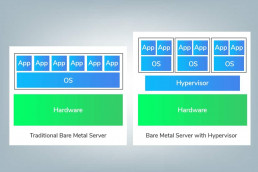
Why Choose a Bare Metal Server?
Bare metal dedicated servers are great for small to medium businesses looking for a cost-effective hosting solution that can quickly automate and scale their resource allocation.
Many experts say that the use of bare metal servers is in decline compared to other hosting options. However, this type of server remains an extremely popular option, especially in many industries. The unique characteristics of the platform allow for an elite level of performance, power, and security.
In 2016, the market for bare metal servers was at a total value of approximately USD 1.3 billion. By 2025, it is expected to reach USD 26.21 billion. Source: Grandview Research
Industries that traditionally rely on dedicated hosting solutions and colocation are the banking and financial services industry, health care, and government. Additionally, bare metal is perfect for critical high-intensity workloads, such as business intelligence or database apps. Render farms and media encoding operations are examples of projects that use this option rather than virtualized servers because of the heightened performance levels.
Innovative software development companies use bare metal dedicated servers as an affordable way to test and launch products.
Industries with the highest needs for data security, world-class performance, and precise data operations are most likely to use bare metal systems. As the demand for storage grows alongside big data, this market will continue to grow with it. Large enterprises within these sectors are expected to drive the majority of usage. Up until 2016, the SMB market was a more significant consumer of the bare metal infrastructure.
The largest driver of growth over the entire market is expected to be advertising and emerging technological advancements.
Advantages
When using bare metal, you don’t have to compete with other users on the same system for resources.
All users can get high performance from this type of server. A dedicated server can deal with a more significant workload than a similar virtual machine in most cases. This makes dedicated hosting best for users who need top levels of performance.
Compared to other types of dedicated servers, bare metal is often easier to manage due to being in a data center. Most providers offer a range of setup options that can be customized to match your exact needs. Managing a server can be challenging and time-consuming. So, having a third-party manage your server for you can be a benefit for many companies.
Managed servers are also more cost-effective than on-site servers. Data centers are more streamlined than in-house setups. So, they can offer more at a lower cost. They also provide other benefits such as a higher bandwidth connection.
Most data centers also offer services that are very valuable to IT teams. Some examples of this are guaranteed uptime, 24/7 support, and regular security audits. Better yet, getting these services from a third-party means not having to hire in-house staff to perform them.
You can learn more about the differences between dedicated servers and public cloud in our post “Cloud vs. Dedicated Server: Which Is Best For Your Business?“
At the Forefront of New Technology
Companies are taking advantage of bare metal infrastructure to employ new technologies in exciting ways.
For instance, containers bring another level of performance capability to the bare metal environment. Running containers on top of bare metal servers provide an alternative to virtual machines (VMs).
Containers surpass VMs in resource usage, as every VM has its minimal overhead while containers use less memory. This makes containers on top of bare metal, the perfect environment for developing apps.
Large enterprises are beginning to experiment with concepts such as machine learning and AI. This type of computing emphasizes big data, mathematics, analytics, and visualization. Considering GPUs are the driving force of deep learning, bare metal’s data crunching and GPU capabilities make it the perfect platform for such tasks.
Understanding the basics of bare metal helps tremendously when trying to make sense of these new developments.
Flexible Hosting Options
Organizations can run bare-metal servers from in-house data centers, a colocation center, or partner with a managed service provider to lease a server.
Each of these options has its advantages and drawbacks, but leasing a bare metal server is the most cost-effective solution for small to medium organizations. Deploying leased servers is fairly quick nowadays, and most IT service providers offer pre-configured dedicated servers that are ready for any specialized workload.
For instance, secure bare metal servers based on Intel Xeon scalable processors are cost-effective enterprise-grade solutions ready for any intensive workload you can throw at them.
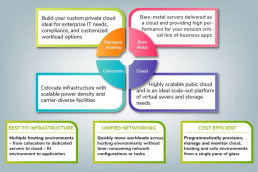
How Long Does it Take to Deploy a Bare Metal Server?
The average bare metal server takes longer to implement than a virtualized environment, which can be spun up in a couple of minutes. It can take anywhere between several hours and even up to a couple of days to provision a server as there is more customization that takes place.
Even though provisioning and maintaining a bare metal server may take more time, it all makes sense once its performance reliability proves to be a game-changer for your organization.
Server Access
Servers are accessed through a private network, and the tenant interacts with the device through remote desktop access. A private network connection is established via a VPN by connecting to a designated end-point. If you want to connect to a Linux-based server, you can do so through a Secure Shell (SSH) tunnel. This way, you can access a server as if it was physically on your workstation. For enhanced security, remote desktop access software encrypts on both the server’s end and your end.
Initially, you access the server as the root user. That’s the ‘all-mighty superuser’ who can do anything on the server. If you want to limit the danger of accidental changes, you will want to create a non-root user.
Managing a Bare Metal Server
There is a general belief that operating bare metal servers requires a large team of IT professionals. While this may be true for an on-premise solution, it may not necessarily be the case when it comes to colocation and leasing. Managed service providers offer a full range of additional services to help you run your online business. This means you can simplify your operations by outsourcing IT work to a service provider and focus on your business goals. For example, if you lease a fully managed dedicated server to resell hosting, you can concentrate on selling your services while your IT service provider handles everything else.
The extent to which you participate in managing the server may vary, but generally, you need to cover the following:
Updates and Patches
Regularly update the OS and perform software patches. This is what protects your bare metal server from malicious attacks. Also, run the chkrootkit, rkhunter, and clamav server application tools regularly.
Monitoring
You need to monitor key operational metrics of the server, switches, firewalls, etc. Set up early thresholds and alarms that will notify when a threshold has been crossed.
Password Management
Regularly change your server passwords, including administrative users and root password.
Remote Hands
Proper management of the bare metal environment includes the ability to customize it across borders without a considerable lead time.
Setting Up and Monitoring Firewalls
These are pieces of hardware or software that prohibit unwanted traffic. A user would set up firewall rules to restrict traffic by service port, destination IP address, or IP protocol. The goal is to know which ports you need to open and for what purpose.
Unfortunately, there is no one-fits-all solution. Each instance may require a unique approach to traffic management.
Operational Management
This includes a myriad of tasks, such as hardware replacement, domain name services, bare metal backup and recovery, migration of data, etc.
Make Good Use of Client Portals and APIs
Most enterprise-grade service providers offer a client portal that grants clients’ insight into their resources and an opportunity to scale easily through a portal interface or an API.
Role-based Access
If a large number of your organization’s members interact with your bare metal infrastructure, you will want to create role-based segregation of duties and permissions.
The Initial Setup of Bare Metal Servers
Identifying Requirements
First, every organization needs to be aware of how they plan on using bare metal. Consider your use case; will it be a database server, network device, or application server; do you intend to use it for dev/QA or production? Every unique use case needs different configurations, and if you don’t do your research, you certainly won’t find the right solution.
When you define your requirements, you can start thinking about the configuration.
Off the Shelf Configurations and Non-Configured Setups
There are off the shelf configurations that are created for specific workloads. Most managed service providers offer servers pre-configured for data crunching, heavy graphical processing, and for other types of specialized workloads. Even if your organization requires a particular configuration, most sales teams will help you procure the right bare metal server.
OS, Control Panels, and Database Software Options
This is one significant benefit of bare metal servers. The entire concept of ‘bare’ implies a clean slate, meaning that you can use the server’s full potential. You pick the underlying relational database software (e.g., MySQL), the operating system (e.g., CentOS, Microsoft Server 2016, Ubuntu, etc.), the control panel and control panel add-ons, you have root access, and you are in full control. You have the option of doing a custom install or setting up your own hypervisor to create a virtualized environment.
All these options can be modified after your initial deployment but be aware that such modifications will require data deletion.
Other Considerations
Bare metal takes more time and know-how to implement than cloud hosting. It can also be less flexible when expanding.
Since you are tied to the hardware, any problems can have a huge impact. Cloud-based solutions circumvent this by not linking the server instance to a single physical machine.
Compared to cloud hosting, dedicated servers are most cost-effective when you are using its resources to their fullest. However, the benefits are often beyond the needs of businesses. Therefore, it is typically best to opt for a cloud server.
To Lease or Buy
Buy
The decision to lease or buy all comes down to your needs and requirements. Purchasing a server provides maximum access to hardware, but that comes at a price. Even if you set aside the necessary and often substantial upfront investments, there are also ongoing server maintenance and administration costs to consider.
It would be best if you considered the Total Cost of Ownership (TCO). TCO includes your initial investments and all operational expenses, such as system uptime, technical support, and redundancy.
If you decide to buy, plan whether you will run things on-premise or lease racks at a colocation center, which set up rooms created primarily to house servers. On-premise will strain your budget as you will need to achieve and maintain data center-like conditions.
On the other hand, private colocation grants you all the interconnectivity, redundancy, cooling, electrical power and stringent security regulations of a data center, while at the same time placing the hardware in your hands. For example, phoenixNAP’s flagship data center in Phoenix, Arizona offers you 30+ unique carrier service providers, including direct access to Amazon’s cloud service and up to 500 watts/sq. Ft. of power capacity.
Generally, colocation is a sensible proposition only if you are looking into expensive high-end servers or are in the market for several bare metal servers.
Lease
By now, you might have noticed that leasing a bare metal server is the most straightforward and most convenient option for most deployments. Ensuring the right conditions and scaling bare metal servers in-house is very vexing. That is why even some large organizations choose to lease as a simple and cost-effective alternative.
Many providers offer fast deployment and high network uptime. For example, phoenixNAP deploys your server within four (4) hours if the order doesn’t come with special instructions, and offers 100% uptime. If a component fails, onsite staff will handle troubleshooting and resolve the issue on your behalf. However, you do need to monitor for hardware fails and submit a support ticket proactively.
Server Location
The next step would be to select the server location. In today’s fast-paced environment, delivering the speediest result is crucial. Google’s DoubleClick conducted a study in 2016 on how slow loading times impact businesses. They reported that “53% of mobile site visits are abandoned if pages take longer than 3 seconds to load.” Response time has a lot to do with location and, typically, you want to avoid data passing through multiple processing points before service delivery.
Regardless of whether you lease or opt to physically place your servers in a colocation center, carefully pick the right service provider. Start by identifying your users’ geographical location. If you are running a global business, the right thing to do would be to find a global provider with multiple presence points.
On-Premise
The alternative here is to buy and physically control the server on company property. This is known as an on-premise setup. However, servers require particular conditions to maintain proper function. Temperature, humidity, proximity to automated cooling, and the server’s physical safety are among the most important considerations.
Additionally, security is of paramount importance. Some industries, such as healthcare and payment processing, prescribe very stringent security rules (i.e., HIPAA and PCI).
Organizations processing delicate information must adhere to these rules, and failing to do so might come at a steep price if a consumer data breach affects their systems or infrastructure. This makes an on-premise setup very complicated and time-consuming. Quality IT service providers maintain PCI-DSS and HIPAA Compliance, thus providing a secure platform for your business.
No organization should install bare metal servers on-premise if they aren’t 100% sure to maintain the proper environmental conditions, maintain efficient redundancy, and adhere to security protocols.
For the sake of simplicity, we will consider the only colocation and leasing bare metal servers for the remainder of this article.
Public Bandwidth
How much traffic are you expecting? Most managed service providers offer somewhere in the range of 15 TB of free public bandwidth monthly. If you predict higher traffic volumes, be sure to upgrade your service plan. Good service providers may offer up to 250 TB of bandwidth at 550Gbps+ capacity to minimize network latency.
RAID Setup
Hard disc drive failure (HDD) is the most common issue you will encounter in your server setup. Moreover, if you opt for a managed service, meaning that it’s not your task to replace the hard disk drive, you certainly wouldn’t want to lose precious data.
A redundant array of independent disks (RAID) is a redundant system that uses multiple hard drives to store your data. This means that data is written to all drives in the array, allowing for a hard drive to fail without losing data. RAID is used for critical workloads where failure and data loss would be catastrophic and detrimental to an organization. Bear in mind that RAID’s objective is to reduce downtime, but it doesn’t eliminate the need for backups.
There are several types and levels of RAID:
RAID 0 – Data is chunked and split between drives using striping, speeding up writing and reading speeds. This setup does not offer any protection. If one hard drive fails, all data is lost. The usable capacity is equal to the total physical capacity.
RAID 1 –This setup uses a process called ‘mirroring.’ It writes data to both hard disks, so you don’t lose data even if one disk fails. Bear in mind that this halves your storage capacity. This means that if you provision 20 TB of storage space, you have 10 TB of usable capacity.
RAID 5 – Data is written across all drives (minimum of three drives) with additional information called ‘parity.’ If any hard disk fails, data can be retrieved using that extra information. The usable capacity will be the total storage less one hard drive. RAID 5 takes performance hits during a write phase, so it is not recommended for database servers.
RAID 10 –This is a combination of RAID 1 and RAID 0. Data is organized as stripes across several hard drives, and then the striped disks are mirrored. The usable capacity is 50% of the total physical capacity.
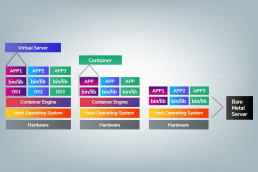
Bare Metal Environment vs. Virtualization
The virtualized environment is the primary alternative to the bare metal server.
Many differences dictate the usefulness of each environment for business.
First, let’s define virtual machines and then look at some of the most important distinctions between the two infrastructures.
When speaking of cloud instances, each virtual machine is part of a shared hosting environment with multiple tenants. For example, each tenant may have one virtual machine on a single shared physical server. In modern deployments, however, virtualized environments can also be dedicated, meaning that there is segregation of hardware.
For example, Private Cloud hosting is one example of a highly customizable single-tenant cloud service.
Generally, VMs are easily scalable and budget-friendly but lack the computing power of bare metal servers.
Performance
A bare metal server outpaces virtual machines in performance, all else being equal. Because there is only a single tenant on a dedicated server, that tenant has access to all the physical resources without having to share. A virtual server may separate clients, but those clients share optimized resources on the same physical server.
The presence of a hypervisor prohibits software that can take advantage of architectural perks of the physical hardware. This places bare metal users in a unique position to make far better use of specific hardware pieces.
Security
Compared to public cloud instances, server colocation and bare metal servers have heightened security because of their isolation away from other clients. In the world of multi-tenant virtualized servers, data streams infected by malware may affect the distribution of resources across the server. Although other data streams are quarantined from the infection, the neighbors may suffer the effects of a redirected resource load.
Resource Usage
Resource usage on bare metal servers is highly predictable compared to virtualized environments. If you plan on crunching data or running apps with unexpected usage spikes, getting a bare metal server is your best bet. Crunching data in the cloud will most certainly get very expensive as you would have to provision vast capacities to maintain predictable performance.
Control
A single tenant exercises more control over a single physical server than a group of people does in the cloud. The bare metal environment allows a client to fully control and predict bandwidth, memory usage, and other important web hosting aspects.
Scaling
Virtual machines are far easier to scale as additional resources can be provisioned in a couple of minutes. This means that with bare metal servers, you need to plan. It is more challenging to scale and adapt to current requirements.
Another thing to consider is that a single VM doesn’t offer enough resources for some use cases. For example, a single VM may be limited to 64 GB RAM, 2 TB of storage, and 8 vCPU. In contrast, a bare metal solution may offer the maximum resource limit of the latest technology.
Long-Term Hosting Solution
Virtual machines are often deployed for short-term use, while bare metal is considered one of the favored solutions for long-term deployments. There are several significant contributing factors.
First, there are no other tenants to compete with for the server’s physical resources, so it is much easier to scale and combine your resources. Even though many service providers don’t place a hard limit on virtual resources, there is a soft limit in place.
Secondly, an organization’s requirements are bound to evolve. The additional customization options bare metal servers feature means that bare metal servers can cater for a wide range of workloads. Furthermore, bare metal can be an excellent starting point for a hybrid environment. A hybrid environment combines bare metal servers and modern cloud solutions to provide the best of both worlds.
Industries with compliance guidelines can make use of dedicated servers for increased security. The sectors of healthcare, finance, and the government should have the financial and personal data of end users stored in compliant infrastructure. Colocation is a good fit for these use cases.
Hybrid: The Best of Both Worlds
It is possible to capture the best of both worlds by bringing together bare metal and virtualization. In this model, each tenant is not tied to a specific physical machine but still has the power and access of a dedicated server. Each physical server has a single virtual tenant running on it.
With a hybrid setup, businesses can run their most demanding workloads while also enjoying cloud hosting’s flexible structure. Users provision and manage servers using a web-based portal. So, the time and cost of configuration can be close to those of services hosting in a shared, virtual environment. This also makes it easy to upgrade servers when needed.
Learn more what is bare metal cloud and the best use cases for the technology are. For more details, visit our Bare Metal Cloud provider service page.
When It’s the Right Choice
Specific workloads suit a bare metal set up better than others. Businesses that have high performance and/or security needs may get a lot out of this option.
Dedicated machines are great for workloads that require a lot of computing resources and low latency. Some examples of this include streaming video, hosting large amounts of graphics, or running taxing web apps. Teams who are rendering animations or working with large amounts of data can also get a lot of mileage from bare metal.
Businesses that deal with compliance or have data that needs to be kept very secure may also prefer to use bare metal. For example, teams that are in the healthcare or finance space are great fits for this offering. It is easier to control access to a dedicated server. Also, the hardware can be set up to meet regulatory requirements.

Are Bare Metal Servers a Good Fit?
Bare metal servers continue to be an essential component of many companies IT infrastructures. There are many advantages to using this environment.
Bare metal offers the best that current technology has to offer. When hosting bare metal with an Infrastructure-as-a-Service provider, you can quickly scale globally by leveraging the provider’s expertise across all professional dimensions of managing such infrastructure. This means that you get an affordable way to cluster your resources, globally.
Other perks of bare metal include the ability to hybridize your infrastructure by unifying your bare metal and virtual assets.
Growing businesses should consider bare metal as a long-term solution for data storage and transfer. There is no better solution when it comes to pure power, the flexibility of structure and customization capabilities.
Recent Posts
What is a Bare Metal Hypervisor? A Comprehensive Guide
Are you looking for a highly scalable, flexible and fast solution for your IT backbone?
Understanding the difference between bare metal or virtualized environments will allow you to make an informed decision.
Take the time here to master the basics:
What are the requirements for your project regarding performance, density, and compliance? These terms will determine your deployment strategy, including the ability to run virtualized environments.
What is Bare Metal?
Bare Metal is just another way of saying “Dedicated Server.”
This is a single tenant environment with direct access to underlying hardware technology without any hypervisor overhead. Bare metal can support many kinds of operating systems on top of its core performance.
The term bare metal refers to direct access to the hardware. It includes the ability to leverage all of its specific features which would not be accessible with type 1 or 2 hypervisor. This would only emulate that environment through virtualization.

What is a Bare Metal Hypervisor?
A bare metal hypervisor or a Type 1 hypervisor, is virtualization software that is installed on hardware directly.
At its core, the hypervisor is the host or operating system.
It is structured to allow for the virtualization of underlying hardware components to function as if they have direct access to the hardware. The hypervisor enables a computer to separate its operating system from its core physical structure and hardware. From this position, the hypervisor can give a physical host the ability to operate many virtual units.
It allows for the opportunity to house many clients on the same server. Server Virtualization allows for a much denser deployment at the cost of the overhead and limited ability to leverage all hardware features.
Each client will experience a simulation of its own dedicated server. However, the physical resources of the server such as CPU cycles, memory, and network bandwidth are being shared between all tenants on the server.
The hypervisor is all about flexibility and scalability. Hypervisors allow for a much more dense utilization of hardware, especially in situations where not all physical resources are being used. Virtualization could, but does not require an underlying OS. Especially when speaking about datacenter related production workloads. Datacenters look at hypervisors being deployed on top of bare metal servers and not within the OS.
The type of image that a virtual environment creates also determines the performance of a hypervisor.
Microsoft, Citrix, and VMware have the three most popular hypervisor systems. The Hyper-V, Systems XenServer and ESX brands, respectively, represent the majority of the hypervisor market today.
Who is Bare Metal Ideal For?
The bare metal environment works well for many types of workloads regardless of company size.
Enterprise data centers require granular resource and access management, high level of security, and ability to scale. Single tenant environments can perform better and do not run into the risk of “noisy neighbors.” There is less risk involved from a security perspective due to physical isolation.
What are the Major Features of Bare Metal?
Bare metal servers are dedicated to one client and are never physically shared with more than one customer. If that client chooses to run a virtualized platform on top of it, they create a multitenant environment themselves. Bare metal is often the most streamlined way to command resources.
With bare metal, clients can avoid what is known as the “noisy neighbor effect” that is present in the hypervisor environment.
These servers can also run equally well in individually owned data centers or co-location, held by IT service providers/IaaS providers. A business also has the option to rent a bare metal server easily on a subscription from a managed service provider.
The primary advantage a bare metal environment is its separation.
The system does not need to run inside of any other operating system. However, it still provides all of the services to the virtual environments that are necessary.

What Are The Benefits Of Bare Metal?
Without the use of bare metal, tenants receive isolation and security within the traditional hypervisor infrastructure. However, the “noisy neighbor” effect may still exist.
If one physical server is overloaded with requests or consumption from one of the tenants on the server, isolation becomes a disadvantage. The bare metal environment completely avoids this situation.
Bare metal also gives administrators the option to increase resources through the ability to add new hardware.
- Lower overhead costs – Virtualization platforms incur more overhead than bare metal because no hypervisor layer is taking the processing power of the server. With less overhead, the responsiveness and the overall speed of a solution will improve. Bare metal also allows for more hardware customization, which can improve speed and responsiveness.
- Cost effective for data transfer – Bare metal providers often offer much more cost-effective approaches to outbound data transfer. Dedicated server environments could potentially provide several terabytes of free data transfer. All else being equal, virtualized environments would not be able to match these initial offers. However, these scenarios are dependant upon server offers and partnerships and never guaranteed.
- Flexible deployment – Server configurations can be incredibly precise. Depending on your workload, you may be able to mix bare metal and virtual environments.
- QoS – Quality of Service often work to eliminate the problem of the “noisy neighbor” occur in the bare metal environment. This can be considered a financial advantage as well as a technical one. If something goes wrong, a client has someone to hold accountable on paper. However, as with any SLA, this may vary on a case-by-case basis.
- Greater security – Organizations that are very security sensitive may worry about falling short of regulatory compliance standards in a hypervisor multitenant environment. This is one of the most common reason that some companies are reluctant to move to bare-metal cloud computing. Bare metal servers make it very possible to create an entirely physical separation of resources. Remember, virtualization does not mean less security by default. Security is incredibly complex and broad terminology, and there are many factors involved.

What Are The Benefits Of Bare Metal Hypervisors?
You may not need the elite performance of a single tenant, a bare metal server. Your company may be able to better utilize resources by using a hypervisor. Hypervisors have many benefits, even when compared to the highly efficient and scalable bare-metal solution.
Choose a hypervisor when you have a dynamic workload, and you do not need to have an absolute cutting edge performance. Workloads that need to be spun up and run for only a short period before they are turned off are perfect for this environment.
- Backup and protection – Virtual machines are much easier to secure than traditional applications. Before an application can be backed up, it must be paused first. This process is very time consuming, and it may cause the app a substantial downtime. A virtual machine’s memory space can be captured quickly and easily using a snapshot tool. This snapshot can then be saved to a disk in a matter of moments. Every snapshot that is taken can be recalled, providing recovery and restoration of lost or damaged data to a user on demand.
- Improved hardware utilization – A bare metal server may only play host to a single application and operating system. A hypervisor uses much more of the available resources from the network to host multiple VM instances. Each of these instances can run an entirely independent application and operating system on the same physical system.
- Improved mobility – The structure of the VM makes it very mobile because it is an independent entity separate from the underlying hardware. A VM can be migrated between any remote or local virtual servers that have enough available resources. This can be done at any point in time with effectively no disruption. This occurs so often that it has a buzzword: live migration. That said, a virtual machine can be moved to the same hypervisor environment on a different underlying infrastructure as long as it can run the hypervisor. Ultimate mobility is achieved with containerization.
- Adequate security – Virtual instances created by a hypervisor are isolated logically from each other, even if they are not separated physically. Although they may be on the same physical server, they do not have any fundamental knowledge of each other. If one is attacked or suffers an error, the problem does not move directly to another. Although the noisy neighbor effect may occur, hypervisors are incredibly secure although they are not physically dedicated to a single client.
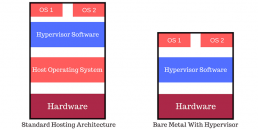
Making the Best Decision for Your Project
Every situation is different, and each requires looking at all solutions available. In the end, there is no definite answer for a bare metal server with native workload versus bare metal with a hypervisor and virtualized workloads. Both options have their advantages and disadvantages, so it comes down making sure that all areas of the business are met.
Once evaluated, the decisions will be made by what your team is most comfortable with and what best fits your needs. Testing both systems is recommended to validate performance as well as how it impacts your infrastructure and your service management.
With the proper understanding of security, scalability, and flexibility, you should be primed with enough tools to narrow down your decision. With some guidance and testing, a bare metal type 1 hypervisor could be the solution your business has been looking for.
Recent Posts
Learn Why GPUs are necessary for Deep Learning
GPU vs CPU Deep Learning: Training Performance of Convolutional Networks
In the technology community, especially in IT, many of us are searching for knowledge and how to develop our skills. After researching Deep Learning through books, videos, and online articles, I decided that the natural next step was to gain hands-on experience.
I started with Venkatesh’s tutorial of building an image classification model using a Convolution Neural Network (CNN) to classify cat and dog images. The “cat and dog image classification” issue is considered by some to be a “Hello World” style example for convolutional and Deep Learning networks. However, with Deep Learning, there is a lot more involved than simply displaying the “Hello World” text using a programming language.
The tutorial code is built using Python running on Keras. I chose a Keras example due to the simplicity of the API. I was able to get the system up and running relatively smoothly after installing Python and the necessary libraries (such as TensorFlow.) However, I quickly realized that running the code on a VirtualBox VM (Virtual Machine) on my workstation is painfully slow and inefficient. For example, it took ~90 minutes to process a single epoch (i.e., 8000 steps and 32 images per-step), and the default setting of 25 epochs required to train the network took more than a day and a half. I quickly realized that the sheer volume of time it takes, merely to view the effect of minor changes, would render this test useless and far too cumbersome.
I began to ponder how I could improve upon this process. After more research, I realized that a powerful GPU could be the solution I was after.
The opportunity to test such a GPU arose when I received a review unit of NVIDIA’s powerful new Tesla V100 GPU, which currently runs at a slightly eye-watering $9,000 price tag. After two weeks with the GPU, I learned many things: some expected and some entirely unexpected. I decided to write two blog posts to share what I learned with the hope that it can help others who are starting their journey into deep learning and are curious about what a GPU can do for them. What’s even more exciting, GPU Servers are available as a robust option for our Dedicated Server product lines.
In the first part of the blog, I focus on the training performance of the convolutional network, including observations and comparisons of the processing and training speeds with and without GPU. For example, I will showcase performance comparisons of the CIFAR-10 with the “cat and dog” image classifications deep convolution networks on the VirtualBox VM on my workstation, on a dedicated bare-metal server without GPU, and on a machine with the Tesla V100 GPU.
After tweaking the processing and training speeds of the network, I worked on improving the validation accuracy of the convolutional network. In the second part of the blog, I share the changes I made to Venkatesh’s model which enhances the validation accuracy of the CNN from ~80% to 94%.
This blog assumes that readers have foundational knowledge of neural and Deep Learning network terminology, such as validation accuracy, convolution layer, etc. Many of the contents will have added clarity if one has attempted Venkatesh’s or similar tutorials.
Observations on Performance & GPU Utilizations
Experiment with the workers and batch_size parameters
Whether the code is running on VirtualBox VM or a bare-metal CPU and with a GPU, changing these two parameters in the Keras code can make a significant impact on the training speeds. For example, with the VirtualBox VM, increasing the workers to 4 (default is 1) and batch_size to 64 (default is 32) improves the processing and training speed from 47 images/sec to 64 images/sec. With the GPU, the gain in training speed is roughly 3x after adjusting these parameters from the default values.
For a small network, GPU Computing is hardly utilized
I was quick to realize that maximizing the GPU for machine learning is a challenge.
With the original “cat and dog” image classification network, GPU utilization hovers between 0 to 10%. CPU utilization also hovers at roughly 10%. Experimenting with different parameters such as workers, batch_size, max_queue_size, and even storing the images on RAM Disk did not make a significant difference regarding GPU utilization and training speed. However, after additional research, I learned that the bottleneck is at the input pipeline (e.g., reading, decompress, and augmenting the images) before the training starts, which is handled through the CPU.
Nevertheless, the system with a GPU still produces 4x higher processing and training speeds than the bare metal hardware without a GPU (see training speed comparisons section below).
The GPU for Machine Learning At Work
After increasing the complexity of the “cat and dog” network, which improved the validation accuracy from 80% to 94%, (e.g., increasing the depth of the network), the GPU utilization increased to about 50%. In the improved network (regarding accuracy), the image processing and training speed decreased by ~20% on the GPU, but it dropped by ~85% on the CPU. In this network, the processing and training speeds are about 23x faster on the GPU than the CPU.
For experimental purpose, I created an (unnecessarily) deep network by adding 30+ convolutional layers. I was able to max out the GPU utilization to 100% (note the temperature and wattage from NVIDIA-SMI). Interestingly, the processing and training speeds stay about the same as the improved “cat and dog” network with the GPU. On the other hand, with the CPU, it can only process about three images/sec on this deep network, which is about 100 times slower than with a GPU.
Training Speed Comparisons
CIFAR-10
The CIFAR-10 dataset is a commonly used image dataset for training GPU machine learning models. I ran the CIFAR-10 model with images downloaded from Github. The default batch_size is 128, and I experimented with different values with and without a GPU. On the Tesla V100 with batch_size 512, I was able to get around 15k to 17k examples/sec. GPU utilization was steady at ~45%.
This is a very respectable result, compared to the numbers published by Andriy Lazorenko. Using the same batch_size, with bare metal hardware running dual Intel Silver 4110 CPU (total 16 cores) and 128GB RAM, I was only able to get about 210 images/second, with the AVX2-compiled TensorFlow binaries. On the VirtualBox VM, I get about 90 images/second.
Cat & Dog Image Classification Networks
The chart below shows the processing and training speeds of the different “cat and dog” networks on different systems. The parameters for each system (e.g., workers, batch_size) are tweaked from the default values to maximize performance. The performance improvement gains from using a powerful GPU, such as the V100, is more apparent as the networks become deeper and more complex.
Improving the Accuracy a Neural Network and Deep Learning
Previously, I compared the training performance of using CPU vs. GPU on many convolutional networks. I learned that the deeper and more complex the network is, the more performance benefits can be gained from using GPU.
In the second part of the blog, I describe the changes I made to the “Cat & Dog” Convolutional Neural Network (CNN) based on Venkatesh’s tutorial which improves the validation accuracy of the network from 80% to 94%. I also share the results of predictions from the trained network against random sets of images.
Improvements to the Cat & Dog CNN
Add Convolutional and Max Pooling Layers
I added a pair of convolutional (64 filters) and max-pooling layers to the original network. The additional depth of the network improves validation accuracy from 80% to 84%. It does not result in any noticeable change in training speed.
Add Dropout Layer
I added a dropout layer with a rate of 0.5, which randomly removes neurons from the trained network to prevent overfitting. The addition of the dropout layer improves the validation accuracy from 84% to 90%. It does not result in any noticeable change in training speed.
Data Augmentation
Data augmentation is a technique that generates variations of training images from the original images through a shift, rotation, zoom, shear, flip, etc. to train the model. Checkout Keras documentation of ImageDataGenerator class for more details. The original CNN already incorporates data augmentations, so this is not an improvement per se, but I am interested in understanding the effect of data augmentation on accuracy and training speed.
The following are examples of augmented images.
To test the effect of data augmentation, I remove the shear, zoom and flip operations from the image data generator. The removal of data augmentation decreases the validation accuracy from 90% to 85%. It is worth noting that data augmentation does come with a performance overhead. Without data augmentation, the training performance on the GPU increases from 425 images/sec to 533 images/sec.
Increase the Target Image Resolutions
The original CNN resizes all images to 64×64 before training the model. I increased the target resolutions to 128×128 and added another pair of convolutional and max pool layers to the network to capture more details of the images. I also increased the number of filters to 64 on all layers. The new CNN with higher target image resolutions and more layers improves the validation accuracy from 90% to 94%. It also comes with performance overhead which decreases the training performance on the GPU from 425 images/sec to 333 images/sec.
Predictions
Now, it’s the fun part, which is to use the trained model for predicting cat or dog images.
Errors in the Original CNN Code
I want to point out that the prediction code from Venkatesh’s tutorial is missing a critical line of code.
Using this code will incorrectly tilt the prediction toward “dog.” The reason is the model is trained by rescaling the RGB values from 0-to-255 to 0-to-1 range. For the model to predict correctly as trained, we must also rescale the input RGB values from 0-to-255 to 0-to-1 range. Without rescaling, the input pixel values are 255 larger than what’s expected by the model, which will incorrectly tilt the result higher toward 1 (i.e., dog).
Another observation is the result[0][0] can return 0.00000xxx for cat and 0.99999xxx for dog, instead of absolute 0 or 1. So, I also changed the check to “>0.5” rather than “==1”. The modified and corrected code is shown the figure below.
Predicting Images
So, how ‘intelligent’ is the CNN? How well can it predict cat and dog images, beyond those in the training and validation sets? Can it tell that Tom from “Tom & Jerry” is a cat? How about Pluto and Goofy from Disney? How about Cat Woman? How about wolves, tigers, and even human faces? Below are randomly downloaded images and the prediction results from the model.
In Closing, GPU deep learning
Having powerful GPUs to train Deep Learning networks is highly beneficial, especially if one is serious about improving the accuracy of the model. Without the significant increase in training speeds from GPUs, which can be in the magnitude of 100x+, one would have to wait for arduous amounts of time to observe the outcomes when experimenting with different network architecture and parameters. That would essentially render the process impractical.
My two-week journey with the GPU loaner quickly came to an end. It was a fun and productive learning experience. Without the training speeds from the powerful NVidia V100 GPU card, all the changes, tweaks and experiments with different network architecture, parameters and techniques would not be possible within such a short period.
Recent Posts
The GPU: Powering The Future of Machine Learning and AI
Machine Learning and Deep Learning: Redefining Global Industry Futures in the Age of Artificial Intelligence.
Introduction
To Learn. By definition, learning is known simply as; knowledge which is attained through study, training, practice or the act of being taught.
Every intelligent organism has been proven to learn. Some beings evolve to communicate with one another. Others, show the potential to transmit knowledge of different species. However, the ability to learn and communicate at a heightened skill level, is indeed what makes us human.
The proficiency to learn from our mistakes and our past, through experimentation and deduction, all while analyzing information is what leads to the acquisition of new skills, more in-depth knowledge, and overall understanding.
Though human nature allows for repeat mistakes, the ability to develop our learning leads to the opportunity of achieving more significant results. With such results come new inventions and drives progress in all facets of our lives. Moreover, through all of our faults and shortcomings, the pursuit of knowledge and the development of our learning is why we have become the advanced species that we are today.
History
Computational models began in the very early 1950’s. Arthur Samuel, an American pioneer in the field of computer gaming and Artificial Intelligence, coined the term “Machine Learning” in 1959. It was then that the concept of Machine Learning began to form from a theory into a reality. The goal for Machine Learning is, and always has been, is for a machine to achieve the ability to learn based on multiple different types of data, and ultimately make predictions, provide expert answers, or guesses without actually being programmed explicitly on how to do so. A machine’s solutions are based on its acquired knowledge: not predetermined by code. Machine learning, and therefore Artificial Intelligence, are concepts meant to handle the recognition, understanding, and analyzation of data. These concepts have been evolving rapidly over time. In most cases, the technological limitations have been the bottleneck for more advanced progression. Until recently, Machine Learning (more specifically its fraction called “Deep Learning”) would take advantage of easily obtained and affordable computational infrastructures which could deal with parallel processing of complex mathematical tasks through the use of advanced algorithms.
These developments returned limited results. As a result, a so-called “AI Winter” set in, where the industry went through a period of reduced funding and interest in Artificial Intelligence. The term, originating in 1984 as the topic of a public debate began due to severe cutbacks in funding, followed by the end of serious research. The interest in Machine Learning began to pick up in early 2000,’s with the creation of the Torch software library (2002) and ImageNet (2009). The opposite of an “AI Winter,” an “AI Spring” began to emerge in early 2010. Now, in 2018, we are turning the page on what could be a global industry surge with AI and Machine Learning.
It’s worth explaining the traditional hierarchy of these systems: Deep Learning is a subset of Machine Learning, and Machine Learning is a subset of Artificial Intelligence.
Primarily, the progress of traditional AI (i.e., knowledge-based, rule-based systems, such as the Deep Blue chess program) came to a halt until large amounts of digitized data and computational power became available over the last ten years. This has enabled computing-intensive algorithms to learn from data. That’s when ML and DL began to shine and became positioned to revolutionize how things work in many industries.
Machine Learning vs. Artificial Intelligence vs. Deep Learning

Industry
Currently, Artificial Intelligence, Machine Learning, and Deep Learning are beginning to provide a competitive edge in the following industries markets:
Health Care
Health care is one of the largest fields where tremendous amounts of knowledge, data, variables, statistics, and unknowns and managed. However, instead of just data, the health and well-being of ourselves and our loved ones are at stake. In response to such high stakes, the medical field is, and always will be, one of the most important industries for AI applications to show and prove its worth.
The analysis of seemingly insurmountably-sized data sets and countless records to identify trends and tendencies, based on limitless variations of medical records, disease patterns, genetic tendencies, etc., is precisely the benefit to having a well-trained and adaptable AI system. Consider analyzing the human genome to discover cures to illnesses or to accelerate life-saving discoveries. These real-world applications are but a few examples of use-case scenarios that medicine will be able to offer us within the very near future.
While many of these applications are in continuous development, helping doctors and researchers alike, we are still in the very early stages of discovering and harvesting AI’s full potential in this field. With unceasing efforts from scientists, developers and hardware manufacturers, we break new performance barriers at a rapid rate. GPU manufacturers such as NVIDIA and Intel empower the industry with the hardware building blocks necessary to achieve better, faster and more precise results that will lead to exponential improvements in our human health, livelihood, and overall well-being for the world as a whole.
Robotics
From logistics to the military, or to manufacturing, robotics play a tremendous role in today’s supply chain industry. Advanced levels in automation have already been achieved with the use of Deep Learning applications. A robots’ ability to build, manipulate, categorize, sort, and move objects has become a cornerstone of the modern manufacturing industry. Additionally, the use of airborne and land-based drones and autonomous vehicles are used in rescue operations, the military, public safety and security, transport, entertainment, agriculture, and even medicine. The combined use of Artificial Intelligence with Robotics is finding its way into more industries every day.
Space exploration is another crucial industry that relies on the use of AI and robotics. Interestingly enough, though NASA is not a branch of the US military, they are an independent branch of the government. Therefore, many technologies, some involving robotics, are in use long before they become part of public knowledge. The intersection of science, technology, industry, and power has always been prevalent, and there is no better example than space exploration.
Marketing
Deep Machine Learning is genuinely changing the game for the marketing industry. Marketers strive to engage, entice, and educate their audience. Deep Learning applicability is virtually endless. It allows for not just clearer understanding and target recognition; it also creates unique and personal engagements based through behavioral patterns and creating timely opportunities. By identifying the ideal clients, to determining the opportune purchase moment of a customer, the applicability of market trends through GPU Machine Learning can disrupt markets and industries. Deep Learning, already, is one of the most significant examples of technology to maximize opportunities and drastically improve costs efficiency for business’. The Ad-tech industry, for example, utilizes Deep Learning for predictions and real-time bidding to recognize and maximize opportunities and radically improve cost efficiencies.
Retail
The retail industry has embraced AI for years. From tracking stock levels to monitoring foot traffic, sizeable computational data is increasingly vital to an industry that often struggles to stay afloat. Consider the future of retail for a moment. Imagine: a densely distributed systems of cameras installed throughout a store, combined with AI image recognition and specific scanning abilities could allow registered customers to pick up items and leave the store without the need to visit a store register. Purchased would automatically be billed to a customer’s credit card upon leaving.
There are many retailers experimenting with this type of AI application for long-term cost savings and unmatched customer convenience. There is also a strategy for customer retention, product placement for foot traffic, and accessibility.
E-Commerce Use of Artifical Intelligence
From chatbots to suggesting new products based on previous purchases or products you’ve researched Artificial Intelligence and Deep Learning is everywhere in the e-commerce industry. These technologies create a personal touch with a customer and enable digital tracking for the marketer. Additionally, recognizing and predicting patterns in consumer behavior has been revolutionary for industries such as airlines and hospitality. Consider how quickly prices can change and adapt based off of events or pattern fluctuations. This information is tailored through detailed AI to maximize both productivity and company profit.
Cybersecurity & Machine Learning
From security penetration testing and monitoring to detection and prevention, Machine Learning and Deep Learning in cyber threat protection’s are growing exponentially. Deep Learning is primarily utilized for identifying anomalies and malicious behavior, such as bad actors or those that intend to harm. It can detect a threat in the early stages or, in an ideal world, prevent an attack from occurring entirely. Well-designed DL algorithms and solutions assist security experts in assessing risks and aid in narrowing their focus from looking at potentially thousands of incidents to analyzing the most aggressive attacks. DL algorithms often provide a visual representation for more comprehensive and quicker analysis. From discovering, predicting, and preventing DDoS attacks to network and system intrusions, DL has become the cornerstone of many reliable tools that SOC teams are utilizing daily.
Driverless Vehicles
Major players in the ride-share community, such as Uber and Lyft, have long understood the importance of driverless vehicles to expand their platform. Even tech giants such as Google and Apple are entertaining the idea of driverless technology with Google’s Waymo program and Apple’s (admittedly secret) “Project Titan” making recent headlines. Naturally, major auto manufacturers are dipping their toe into the water as well, with automation enhancements like Tesla’s “Autopilot” features. Striving for flawless autonomy in transport is a lofty goal, but one many are eagerly attempting.
Deep Learning and Inference are at the core of this industry, and while it has its multitude of challenges, ranging from technological impediments to government regulation, the fact that we will be surrounded by self-driving vehicles for personal and industrial purposes is unavoidable. While we may not be a fully autonomous transport society yet, a smart, self-driving automated future will be the reality in the years to come.
Human Resources and Recruitment Industries
HR is a prime example of when AI and DL can aid an industry that is overloaded. Companies such as LinkedIn and GlassDoor have been utilizing this technology for years. Scanning profiles for specialized skills, industry experiences, activities, location, and even competitor experience is nothing shy of necessary in the modern world.
The days of handing over a CV to be peer-reviewed entirely are all but gone. Now, algorithms will have a much better picture of your experience and personality, based not just on your CV, but also on your social media and online presence combined with behavioral patterns of your profile (age, gender, location, etc.). Your interests, as well as theoretical predictions of your next move (do you change jobs often), are compared to other potential candidates for a likelihood of being hired.
As intrusive as this may initially appear, automation and algorithms have a distinct advantage of bypassing any personal preferences and biases from recruiters themselves. DL and AI will ultimately run the future of HR.
Financial Industry
Fraud detection/prevention is some of the most relevant and public-facing risks that the banking and payment providers face. Predicting economic and business growth opportunities to make and/or suggest sound investment advice that minimizes risk is aided by GPU Deep Learning and Artificial Intelligence platforms. Having a system that continually monitors the entire industry for pattern-building trends is not only essential, but it is also impossible to do on a human scale. Companies that utilize AI and DL technologies tremendously increase their chances to disrupt established market incumbents.
Weather, Climate and Seismic Data
From weather pattern predictions, advanced storm modeling, and even disaster prevention, Artificial Intelligence plays an integral role in the weather industry. Constant monitoring of potential network threats can create countermeasures so that people can evacuate an area in the face of natural disasters such as hurricanes, tornadoes, earthquakes or even wildfires and flooding.
Accurately predicting a natural disaster or the potential destruction of urban infrastructure or crops can allow investment firms and stock market players to maximize their profits and minimize their risk with the correctly placed (or avoided) investment. Additionally, the oil and gas industry is benefiting from the use of AI in underground resources distribution, pocket sizes, and locations allowing for maximized efficiencies, but also minimizing environmental impact.
Big Data
Data mining, statistical analytics, and forecasting have incredible applications in various markets and are becoming increasingly crucial in business and political decision-making. The tremendous amount of data that is being collected is useful not just for AI, and it’s prediction algorithms, but having the ability to access historical and real-time information at an immediate rate allows decision makers, in all fields, to make more informed and calculated choices (personal human biases aside).
While AI can assist with prediction and pattern-recognition with large datasets, humans are ultimately responsible for final decision-making choices and as such, are liable for all consequences. With the assistance of a well-trained AI algorithm, those consequences are becoming less and less.
Enter GPU Machine Learning
Groundbreaking technological advancement for the Machine and Deep Learning industry was developed not long ago. The Graphics Processing Unit or GPU Server was created. Most CPUs work effectively at managing complex computational tasks, but from the performance and financial perspective, CPUs are not ideal for Deep Learning tasks where thousands of cores are needed to work on simple calculations in parallel. The application of general purpose CPUs tends to be cost-prohibitive for such purposes, and this is where the development of the GPU came from.
Initially developed for image rendering and manipulating purposes, developers realized they could use GPUs for other tasks due to the nature of their design and their massive ability for parallel processing. With thousands of simple cores per single GPU, these components quickly became the foundation for today’s Deep Learning applications.

Deep Learning Training
Deep Learning Neural Networks are becoming continuously more complex. The number of layers and neurons in a Neural Network is growing significantly, which lowers productivity and increases costs. Deep Learning deployments leveraging GPUs drastically reduce the size of the hardware deployments, increase scalability, dramatically reduce the training and ROI times and lower the overall deployment TCO.

Deep Learning Inference
Trained Neural Networks are deployed for inference in production environments. Their task is to recognize spoken words, images, predict patterns etc. Just like during training, speed is of utmost importance especially when a workload deals with “live predictions.” Besides processing speeds; throughput, latency, and network reliability also play a vital role. Deployment of GPUs in the cloud is the solution.
Developers, data scientists and hardware manufacturers jumped on this opportunity, with NVIDIA leading the charge on the hardware side. Now, because of companies such as NVIDIA, there is a developed software ecosystem supporting a wide range of Deep Learning frameworks, applications and libraries. GPUs shine with the ability to harness multiple processing cores and scale to handle tremendous amounts of simultaneous instructions. General purpose CPUs still make a more in-depth impact in the AI segment for being cost-effective, so they are easy to distribute as components for Inference and to support GPUs in network and storage parts of computational tasks. Graphics Processing Units are genuinely the hi-tech leaders to support today’s massive and continuously rising demand for infrastructure-parallel processing capabilities.
From Artificial Intelligence, Machine Learning, Deep Learning, Big Data manipulation, 3D rendering, and even streaming, the requirement for high-performance GPUs is unquestionable. With companies such as NVIDIA, valued at over $6.9B, the demand for technologically powerful compute-platforms is increasing at record pace. Additionally, the projected Deep Learning market is valued at $3.1B for 2018 and expected to increase to over $18B by 2023.
Many deep neural networks are deployed with new Convolutional Neural Networks (CNN) and Recurrent Neural Networks (RNN) on a regular basis. This makes it nearly impossible and imprudent naming them all. Though we don’t have the opportunity to interact with every network that is built, there are some very real use-cases where we do interact with on a daily basis. Facial recognition, natural language processing, and voice recognition are some of the most identifiable Deep Learning applications.
CNN’s tend to be engaged in image related tasks, and RNN’s are more versed in voice and language patterns. However, there are many additional Deep Learning frameworks which tend to be more suitable for different variations of tasks. The most popular frameworks include:
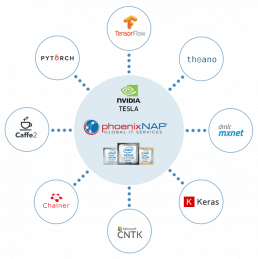
- TensorFlow – one of the most popular DL frameworks today and excellent for speech recognition, text classification, and other NLP applications. TensorFlow works with CPU's and GPU's alike.
- Keras- great for text generation, classification, speech recognition, and suitable to run on GPU and CPU alike, uses Python API. Keras is often installed with Tensorflow.
- Chainer – best suited for speech recognition and machine translation, supports CNN's and DNN's alike, as well as NVIDIA CUDA and multi GPU nodes. Chainer is Python-based.
- Pytorch – primarily used for machine translation, text generation, and Natural Language Processing tasks, archives great performance on GPU infrastructure.
- Theano – suitable for text classification, speech recognition, but predominantly this framework allows for creating new Machine Learning models and uses a Python library.
- Caffe/Caffe2 – prized for its performance and speed, primarily used for CNN's image recognition purposes. It uses a Python interface and has many pre-trained models ready to deploy without writing any code with Model Zoo. Caffe/Caffe2 works well with GPU's and scales well.
- CNTK – works well with CNN and RNN types for respective image and speech recognition as well as text-based data. It supports a Python interface and offers excellent scalability across multiple nodes and offers exceptional performance.
- MXNET – supports multiple programming languages and CNN + RNN networks being very suitable for image, speech and NLP tasks, and is very scalable and GPU focused.
Conclusion: GPU Machine Learning and AI
If current interests (read: funding) remain at the same level, and the robot uprising doesn’t throw off investors for a few years, we will only see more advancement within the field.
The human brain is a very creative and capable organ, and mimicking it through a combination of software and hardware is not particularly easy. However, we as a species will continue advancing our technology, improving our neural networks, developing new Deep Learning techniques, produce more capable and powerful software, and continue working on the ultimate goal of creating a world where computers can help us advance faster, understand better and learn quicker.
Will this ultimately lead us to the development of singularity? Likely not, but we will surely find out eventually. For now, Artificial Intelligence and Deep Learning create tremendous market opportunities on a global scale and are aimed at improving our lives and the world around us. It is not just redefining industries and markets, but its applications are life changing.
Recent Posts
Managed Server Hosting vs Unmanaged: Make An Informed Choice
Your business relies on servers to keep your website, e-commerce, email, and other vital functions performing at peak condition.
Choosing the right server solution can make a difference in your web hosting experience.
Companies have two primary options for dedicated hosting: managed and unmanaged.
Understanding the differences and advantages between the two types helps companies make an informed choice.
What Is A Managed Server? A Definition
When you choose managed services, you gain technical expertise. Managed server hosting companies will install and manage software, troubleshoot issues, and provide a control panel for you to handle basic tasks.
With a managed server, the provider will configure the server for you and make sure that the right software is installed. The company will complete the necessary maintenance work.
One significant benefit of a managed dedicated server is support. When something isn’t working correctly with your server, it’s up to the vendor to fix the problem.
What is Unmanaged Server Hosting?
The most important difference with an unmanaged server is that you are responsible for the management, server health maintenance, performance, and upgrades. Generally, managed servers are best for companies that have their own information technology departments.
A web hosting company may still set up the server for you, but after that, it’s up to you and your team to ensure it remains functional. If you and your team have the right skills, an unmanaged solution may make sense.
In an unmanaged hosting situation, you will still have a web host. But the initial setup may be the most significant component of the services provided. Contractually, the web host will be responsible for the physical hardware and making sure that your site and company are connected to the internet.
That means that when components fail, servers need to be rebooted, networks need to be maintained, or weird error messages appear on your site, you are responsible for fixing them. Software installs and upgrades and security patches are your responsibility.
In some cases, hosting accounts can be used to address these issues when they arise, but the costs will be expensive when accessed on an ad hoc basis.

Advantages Of Managed Servers
Companies considering their hosting solution should discuss the benefits of dedicated server options. For managed solutions, the primary consideration is support.
Managed servers provide a cost-effective way to ensure operational uptime for your company and its critical functions. The provider owns the hardware, and it is leased to the client.
When there’s an issue, the provider will diagnose and resolve the issue.
Here are a few of the core benefits to managed servers:
Initial Setup
Your provider will configure the hardware and install the proper operating systems and software. Proper server configuration ensures that your applications run effectively and securely.
Support
One of the main advantages is the day to day support you receive. The team is available to respond to issues in your moment of need. Look for a provider with 24x7x365 availability.
Back-Up and Storage
You need access to data on your server, and the managed service provider ensures it’s available. Data loss can be devastating for any business, and proper redundancies ensure that information is backed up and stored securely.
Disaster Recovery
In the unlikely case of an attack or natural disaster, your service provider will have your systems up and running with minimal downtime. Often, managed server solutions rely on data centers in multiple locations with continual data backup functions to keep information secure and safe. Having the right hosting provider ensures continuity of service and customer retention
Server Monitoring
Monitoring of servers using tools or software is critical to any hosted web services, ensuring that communication, data, and access are fully functional at all times. Managed services provide continual monitoring to look for irregularities and can act on those issues before they become a significant problem.
Security
Whether it’s a system infiltration attack or a distributed denial of service (DDoS) attack, your company needs a solution that is up to date and monitoring access and activity. Having DDoS prevention can save money and provide peace of mind.
Upgrades
When there are software updates or security patches that need to be installed, your service provider will ensure they are deployed to your dedicated servers.
Flexibility
Having the right service provider allows your organization to secure the level of dedicated hosting to meet your evolving needs. As demand scales up or down due to expansion or seasonal differences, your server can adjust accordingly. When you need additional resources, your host provider can scale accordingly.

IT Cost Savings
One key component of having managed dedicated servers is the ability to save on IT costs.
Consider the costs of recruiting, hiring, training, and supporting a full team of technology professionals. You’ll need to factor in salaries and benefits, including the need to have potentially three shifts of employees available to monitor and maintain your servers.
With an outsourced IT team and managed dedicated servers, businesses can reduce your personnel costs considerably. Managed hosting provides a cost-effective way to deliver high performance without extensive investment in personnel and related expenses.
If you have a smaller IT team, you can rely on a hosting solution to reduce the burden.
Control When You Need It
With managed hosting, you also have access to an administration console. These tools allow you to control key areas of your website or applications, such as adding and deleting users, adding new email addresses, and other essential functions.
These web-based interfaces give you the ability to manage content, access, and functionality. For daily management of your site, including blogs, e-commerce, content management, and the forward facing components of your business, having these tools available is critical.
These administrative functions are a common component of most managed providers core services.

When Do I Need Managed Server Hosting?
Unmanaged hosting may appear to be a less expensive option, free of the need to engage in contracts for support.
Consider the following situations and whether the provider has the skills and resources to handle these issues:
- The server needs to be rebooted.
- Customers cannot access the site.
- Hackers are trying to gain access to your server.
- Your server is unable to withstand the volume of traffic, slowing down or performing poorly.
- Your software needs to be patched or updated.
- Your data is corrupted and unusable.
- A flood, fire, or hurricane affects the physical location of your server, making it difficult or impossible to access or use.
These are situations when having a hosting solution is the optimal choice. Whether it’s an operating system error or a software upgrade, you want to have a reliable team available. A dedicated server managed by a professional team of experts can bring their experience to bear on your issues and get them resolved quickly.
Here are some of the situations when having a managed web hosting solution makes the most sense.
- Previously shared space. If your company had previously used a public cloud or other shared server space, but needs its own hardware, managed hosting makes sense.
- Server reliance. Any business that relies on hosting ecommerce, websites, or public access to data and information should consider a single tenant structure.
- Small or no IT staff. Companies with limited internal IT staffs or smaller teams should consider a managed solution. With an external organization to adequately manage your server and fanatical support, your company can leverage the extended support capabilities.

Questions to Consider With Dedicated Server Hosting
Which solution is the right choice for your needs? That decision largely depends on the answers to the following questions:
- How much technical expertise is available at my company to maintain servers, networks, infrastructure, and hardware?
- How critical is it that websites, email, and applications are available all day, week, and year? What are the consequences of downtime?
- What administrative controls do I need for the website, email, and access?
- Can I back up and protect my data in the case of a cyber attack or natural disaster?
Choosing the right server solution can have a transformative impact on your business.
With the proper support and security, your organization can confidently pursue revenue-generating work, focus on customer service and acquisition, and deliver quality products and services.
Contact us for a custom quote. We are standing by to customize your hosting experience.
Do You Have the Best Server for Your Business?
Contact phoenixNAP today.
Recent Posts
Windows Server vs Linux: The Ultimate Comparison
In choosing a server operating system, Windows comes with many features you pay for. Linux is open source and puts users in the driver’s seat for free.
Let’s consider the server as the software to handle the tasks of the hardware. The hardware can range from a single host-computer connected to an internal network, to a high-tech array of external hardware services on the cloud.
Which system you use—Windows vs. Linux—to power your server, depends on your business needs, your IT expertise, and the software you want to load. It could also determine the type of provider you want to work with.

Advantages of Windows Server OS
The Windows server package, professionally designed by Microsoft to make a profit, has some compelling advantages. Pay for your service and receive better support than open-sourced Linux, which is more or less community developed and supported. Windows customer support, as expected is through Microsoft and their resellers.
Your Windows applications (Outlook, Office, etc.) will integrate with Windows servers straight away. If you use Windows software and services, it makes sense to run them on a native platform.
If you are running a database backend based on Microsoft SQL, it will not run on a Linux server, unless you install a Windows emulator. To do this, you must purchase a copy of Windows and the database software separately.
Windows server is often considered a complete solution that is quick and easy setup. If you want remote desktop access with an intuitive graphical user interface, Windows offers this without command-line programming which is required by Linux.
Does your business require scripting frameworks like ASP and ASP.Net? An ASP, or Active Server Page, is a web page that includes small embedded programs—i.e., scripts. The scripts and web pages you develop from those programs will run only on a Windows server. The Microsoft server processes these scripts before the page loads for a user. This is not possible with Linux.

Benefits of Linux servers over Windows
Linux is an open-source operating system (OS) and IT infrastructure platform allowing distributions such as Ubuntu, Fedora, and CentOS. Its source code is available for coders to change and update the way the software functions. Users can go to the source to edit features or fix bugs.
Linux, because it is open-source, is free. The web host only needs to pay for technical support to install and maintain the program (if required). Business Server providers do not need to pass along additional costs to the customer. On the other hand, with Windows servers, the company typically must pay for the operating system and a periodic use license.
Linux has instant compatibility with other open-source software products and provides a quick interface with seamless adoption. Linux users can run Windows programs, but they must buy interface software and pay for Windows licensing. That comes in handy when you have legacy applications that must run on a Windows emulator.
Linux servers and the applications they run generally use fewer computer resources as they are designed to run lean. A bonus is that programmers can modify Linux servers and software “on the fly” and without rebooting, something that is not possible in a Windows environment. Microsoft Windows servers tend to slow down under multi-database tasking, with a higher risk of crashing.
Linux is more secure than Windows.
While no system is immune to hacking and malware attacks, Linux tends to be a low-profile target. Because Windows runs the majority of the software in the world, hackers head for the low-hanging fruit—Windows.
Windows vs Linux Server: Head to Head
Now that we have given equal time to both Windows and Linux, let’s make three final head-to head-comparisons:
1. The learning curve to install and manage a Linux server is steep. Windows users don’t need to be a programming expert to customize the server.
2. Linux is a better choice for web developers who can configure an open-source Apache or NGINX server. Likewise, developers working with a MySQL database know that Perl, PHY, or Python development tools are long-time favorites, with broader online community support.
3. A Windows server package includes technical support, along with regular system upgrades and security fixes. Linux technology has proceeded at a slower rate of change. It is a trimmed down system. You don’t have to upgrade for features you may not need continually. You can add those features to Linux yourself.

Linux & Windows Server Costs
On a Windows configuration, expect to pay more to get the exact features you need. For example, a managed Sharepoint site or an Exchange server can take you beyond the features offered by the average Windows-based servers. Ask whether they are available and see if you can get help in configuring them.
Again, be aware that your existing database software will only work on a MySQL server. Also, if remote computing is in your future, you also need to ask about remote desktop access.
If you are in the Linux camp, you’ll need a host that eases your access to common Linux tools such as PHP and MySQL. Look for advanced features, like the ability to use time-scheduling jobs.
Making the Server OS Decision
When you make your decision to either go with Windows or Linux, you will want to find a reliable and experienced provider to help with installation. Consider the following factors in your final decision:
- Do you need 24-hour, quick response support, and is your eCommerce site mission critical? Windows support comes with the product. Linux responses might not be so fast.
- Can you get by with shared hosting solutions or do you need the benefits of a dedicated server? The latter is more expensive, yet more secure. The former is cheaper, yet less secure; you share bandwidth and resources with other customers on the host’s system.
- What are your plans for future growth? Automatic scaling to allow your secure data storage and bandwidth to grow as your business grows is something that needs to be part of the service.
- What is your level of interest in cloud computing? Is it important to go all in, or go for a hybrid solution to keep your data closer?
Summary: Linux Server vs Windows Server Comparison
Deciding between Windows and Linux requires an understanding of the pro’s and con’s of each system, as well as how they fit into your hosting needs.
You can work across platforms with Windows and Linux. Be aware that the convenience comes at a cost. You must pay for the software and application licenses if you need to run Windows on Linux.
If you choose Windows, and you get a simple installation and configuration, as well as excellent support. If you go with Linux, you are working with an open-source OS with a community support network—without the higher costs.
Once you have decided between Windows and Linux, look for a provider who can accommodate your needs, based on your companies business model and needs.
Recent Posts
What is a Dedicated Server? A Definition
You’ve noticed or had customer complaints that your application or website has been running slow. You have a reputable hosting provider, at least you thought you did, but you come to find out that you’re using shared hosting.
Apparently, there are other people within your server hogging all of the resources that you didn’t know you were sharing in the first place. Now your provider is recommending you buy a dedicated server to improve your site’s performance.
But what exactly is a dedicated server, and how does this compare with what you thought was working fine?
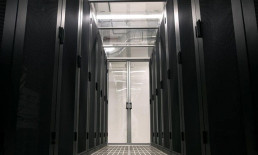
Dedicated Server Definition
A dedicated server is a computer set aside for a specific task, such as hosting a resource-intensive application or website. Dedicated servers can take several forms.
With a dedicated server, the server is a computer that is reserved explicitly on a network for your application or website.
For many web hosting companies, the standard type of hosting, or at least the lowest priced option, is in the form of cloud hosting. When your company chooses a public cloud provider, your application and website may reside on one or many computers and utilize cloud computing.
In a shared hosting solution, your website or app is vying for resources with an unknown number of other software applications. This creates a potential situation listed above where you start to experience slow-down or lag from someone else. These additional software applications and websites may use resources that your applications or site needs.
When speaking about dedicated servers with hosting companies, the service provider sets aside one server (or a single machine) to handle the workload the website or application requires. Managed servers give you access to your very own private cloud and give you the flexibility of cloud hosting but with your own resource center’s added security and speed.
In-House or Off-Site Servers?
In some cases, a dedicated server can be on-site at your place of business.
There are pluses and minuses to this type of solution.
The obvious benefit is that you have complete physical control of the hardware and who has access to it. This is extremely useful for companies that require the security of a closed computer network and a private cloud.
The security measures on these machines are often more stringent than those for companies that need website hosting. Companies that deal with financial data, medical records, or sensitive government regulated data are more likely to choose this option over companies that don’t require such measures.
The downside to having an in-house server is maintenance and scalability, especially if the machines are self-managed. Should you choose to go this route, you will regularly need to update your hardware and software, costing a company in time, resources, and money that could be utilized elsewhere. If you decide to outsource maintenance, there’s the problem of vetting technicians and ensuring that everything is completed to your satisfaction. You must also have a server room (or at least a place) that is appropriately climate and access controlled.
Backups and redundancy are something to consider with your own server.
If there is a problem with your data, if there is a catastrophic incident (hackers, disk failures, and natural catastrophes), or if there is a need for maintenance, you or your team are directly responsible for handling downtime. If your business requires that your servers be up and running 24/7, you will need to develop a plan to ensure that your applications or websites will still run when your primary server is down.
Off-site servers through a hosting company allow the application or web hosting company to provide a dedicated server but off-site, presumably at the hosting company’s data center. Companies most often rent these servers from hosting companies and have the hosting company handle the complexity of backups, redundancy, maintenance, and upgrades.

Dedicated Servers for Software As A Service (SaaS) Providers
Another business model that often utilizes dedicated servers is Software-as-a-Service (Saas), providers. By using the dedicated server as infrastructure to provide Software-as-a-Service products, companies can focus on their software rather than worry about infrastructure related concerns.
SaaS generally needs to be web accessible 24/7/365, so reliability is of vital importance. By leasing these types of servers from companies that are in the business of providing dedicated hardware, SaaS providers get a server that they can rely on. By allowing their provider to address any infrastructure related issues as they arise, they free up their technical staff’s valuable time to get back to doing what they do best—providing excellent software solutions for their customers. Many SaaS companies offer backups, support, and server management. Because dedicated servers can be rented rather than purchased outright, this option can provide an excellent way for small and medium-sized businesses to have the computing power of larger corporations.
SaaS providers often find it helpful to hybridize and use cloud resources as well. Administrators will often use the cloud to test out applications for software development and quality control before moving applications and websites over to dedicated servers.
Benefits to Dedicated Servers
There are many benefits to using dedicated servers.
The benefits include:
-
- Speed and agility. Your applications and websites have the advantage of being able to use all the resources on the server, without vying for resources with other applications.
- Security. You are less likely to have your programs and websites hacked because your sites and data reside outside of a public cloud and may be able to put into effect more security measure.
- Control. In some instances, a dedicated server (especially on site) allows more control over your hardware and software.
- Scalability. You can request more CPUs, more extensive networks, and more disk space if your applications require them. You can also upgrade to a faster and larger server that can handle the workload your websites and applications need.
- Customizable. Since you are renting or purchasing this server, you can have it set up any way you’d like.

Considerations with Dedicated Servers
When deciding on a dedicated hosting solution, you need to consider the following:
-
- Rent or Own Your Server? Depending on your needs, you may consider renting or owning a dedicated server. Renting gives you the ability to upgrade often seamlessly.
- Scalability. How many disks, processors, and network connections do you need up front and in the future? Knowing and understanding your needs will put you ahead when your business expands.
- On-Site or Off-Site? If you choose to keep the server in-house, you will have to have an appropriate place to house the server. It will need a climate controlled room with network connections. Who will administer the computers? Do you hire a third party to manage them or use someone in-house?

Should You Go With a Dedicated Server?
Dedicated servers, by nature, have actual hardware and software dedicated to a business’s application or website.
The question many business owners ask is if they should go with a dedicated server or if they should stay with cloud hosting? At first, many business owners opt for the cloud servers because of the attractive price. However, the choice becomes obvious when their applications and websites bog down due to heavy resource usage and high traffic. Often, they find themselves scrambling for better solutions when they should have chosen a dedicated server in the first place.
Businesses that have sensitive data or must comply with government regulations need to choose a dedicated server to decrease the potential risks to their data and possible loss of revenue and hefty fines. Any company that wants control over scalability and customization should consider using a dedicated business server over a cloud server.
In the long run, a dedicated server may prove to be advantageous to any business that works in E-commerce or requires agility on the web.
Recent Posts
Small Business Servers: Do You Really Need The Best Performance?
The server that you choose makes all the difference in your business efficiency. Depending on your decision, it could also thwart or aid in your ability to expand. Selecting the best server for your small business does not have to be a hassle. There are the standards that you can count on to make the right choice.
First, let’s go over the essential functions of a business server. Then, we will touch on the operating systems that drive servers and make them perform. These are two of the most critical aspects of choosing a server so that you can make an informed decision for your business.

Understanding The Functions Of A Small Business Server
Small to Medium Businesses need servers that scale to their needs. You should not overpay for resources that you do not use though this is a typical sales practice to bundle features into a solution. You should also have adequate hardware to deal with unexpected traffic spikes. Once a marketing program starts working, you will likely see improvements in your online traffic. You need a server that can handle these increases.
Here are the most common uses of a server in the small business environment:
-
- Securing hosting email. Startups can start by utilizing Gmail, Yahoo, or Mail.com, but it’s best to transition into a domain-specific email client quickly. SMBs should upgrade and think more deeply about security and their digital reputation.
- Hosting eCommerce. The right server provides secure and efficient commercial transactions. Your company must protect the personal and financial information of its clients. You may be held legally responsible for the unprotected information. Hosting eCommerce securely is essential.
- Hosting a website. You want your content to be available to your audience. Your web host determines the speed and efficiency of your site. Your web host can also make a tremendous difference in your search engine ranking.
- Hosting applications. Hosting apps on a remote server reduces your need for new hardware. Instead of purchasing equipment to store in-house, you can rent it through the cloud. Some common uses for internal apps include employee management, CRM, planning and invoice management SaaS apps.
- Creating a virtual server environment. Does your business cover multiple brands? You may need a virtual server interface. Do your employees work remotely? You may need virtual desktops. Your small business server hosting can make this happen.
- Data backup. You increase data storage security for your business when you back up to the cloud. If something unexpected happens, you can quickly reload a saved instance of your business. There is very little lag when this process is used efficiently. You may not even have to inform your customers that anything went wrong.
- Storing documents. Storing documents is essential for business continuity and data protection. It also aids in disaster and data recovery strategies. You can also enable employees to work remotely.
A remote server can deliver many other services to an SMB. Powerful small business servers can support all of these services at the same time and more. Many companies will use separate servers for each feature. This makes a company more accessible to expand digitally.
Your Operating System
The operating system is of vital importance. Imagine if your home PC ran on an OS that you couldn’t work with and ultimately did not like to use. You would be quickly finding a solution that worked and was much more effective. Think of the operating system in the same way.
Server software requires a specialized OS. It’s not often that you’ll see the same operating system on your desktop as in a server. There may be similarities, but ultimately the functionality will be different.
Here are your main choices when it comes to selecting the best server os for small business:
-
- Linux. This semi-popular desktop operating system is more often known as a server OS, made to work for many users simultaneously. Linux has many variations that combine a full OS and a package manager. You end up with a faster install and better operations this way. The most popular distributions for Linux includes Debian, CentOS, and Ubuntu.
- Windows OS. Microsoft names its OS after its desktop operating system, but rest assured that they are dramatically different when it comes to functionality. Microsoft Windows Server includes apps that support virtualization, security and the IIS web server.
Linux is more popular than Windows, server-side. Linux is free in many cases. It is also more efficient and less open to being hacked. Linux also can support many of the most popular open-source software options. Many Linux software packages are also free.
Windows offers a more pleasing graphical user interface (GUI) for server management. Linux requires learning complex command line syntax. Additionally, many business owners prefer to use Microsoft to complement their current base of applications. These applications often include Active Directory, MS SQL, and Sharepoint. These Microsoft branded programs run far more efficiently on their native platform.
Support is also a reason companies will lean towards Microsoft. They are known for years of helpful and responsive support. With Linux being open-source, your options for support are either researching yourself through online message boards or contacting your Linux distributor.

Dedicated vs. Cloud Servers
Once you’ve settled on an operating system, you need to decide on your server’s hardware infrastructure (to be fair, these choices would be made simultaneously). Your two main options are between a dedicated server versus a cloud-based server. They are both self-contained environments that are fully complete. However, the underlying hardware of each server type is used differently.
The Cloud For Small Business
Think of a cloud server as a piece of a dedicated server, in a way. From a customer perspective, you will receive similar benefits. However, you actually share the physical space with other clients. The thing is, you’ll never know that you’re sharing space or how many other people you’re sharing it with unless a major issue comes up.
The cloud is comprised of virtual machines. They run on top of an enterprise-grade dedicated server. The dedicated server can create multiple virtual servers and provide a virtual environment for each client.
Power
Each virtual server functions as a slice of a dedicated server. The virtual cloud server is always weaker than its bare metal base, but a virtual server can still be incredibly powerful.
Cloud servers can receive resources from many dedicated servers, creating a virtual space that can match the credibility of a dedicated environment. The total power available in the cloud depends on the physical servers providing resources.
Cloud servers have more than enough power to handle the needs of a small business. Multiple servers work together to manage various companies at the same time.
Resources
The Cloud can host websites, applications, file sharing applications, email clients and eCommerce. The primary functions are the same as a dedicated server though due to hardware differences, speed may suffer in a cloud environment.
There is a built-in latency that slows down all virtual servers regardless of their infrastructure. The extra layer of virtual processing between the base OS and outside requests for data requires more time regardless of the total resources that are available.
Efficiency
Even the best cloud provider will almost always lag behind even a moderate dedicated server. That said, it’s worth mentioning that most SMB’s do not require a dedicated server. Even if they do, they are so cost-prohibitive that it’s often more economical to weight the minimal differences in speed vs. performance as an overall hit on a business’s finances.
Cloud server hosting infrastructure is efficient enough to handle the needs of most small businesses and with minimal customer engagement. The company managing the server is just as important as the infrastructure. Make sure that you choose a reputable web hosting company with strong storage solutions.
Scalability
The virtual server is much easier to scale from the perspective of the client. Scalability, outside of cost, is the main advantage of the cloud over a dedicated server.
There must be available resources to allow a business to scale their server. The one disadvantage of the virtual space is that in a live environment, clients compete for resources. If many clients experience unexpected traffic spikes at once, the server may experience the “noisy neighbor” effect. There may not be enough resources to go around in this case and could cause a problem for multiple clients. Thankfully, this situation is often mitigated by a reputable host that is actively managing traffic across the network.
Scalability is also a perk for a growing business when they are looking to expand their entire environment. There is no need for downtime to add resources to the virtual space which becomes extremely attractive for companies. Adding cloud storage is an incredibly simple task. There are also many hosting companies that are investing strongly in machine learning architecture to better utilize resources.
Speed
The cloud can be slower than dedicated solutions because of the built-in lag. Speed in the world of virtual servers is a resource that can become volatile. If too many clients are vying for the same resources, the cloud slows down. Dedicated resources are always going to be faster, but with advancements in technology and a reliable hosting provider, these limitations are becoming less and less.
Cloud Server Pricing
Cloud servers are less expensive than dedicated business servers. There are many clients on a single piece of hardware. Each client only pays for a fraction of the resources on the physical server.
There are also fewer resources allocated to each client. In return, the price is much lower.
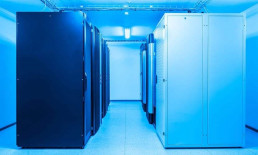
The Dedicated Server
The dedicated server is yours and yours alone, though it will most likely live inside of a data center. You don’t share it with another company, you don’t have to worry about another company hogging your resources, and you’re entirely responsible for it. Providers can service many clients simultaneously. When you rent a dedicated server, you are reserving your own dedicated space for your business. There are many advantages to this configuration though it’s not always ideal for every small business.
Power
Dedicated servers are the most powerful option for a server. The purpose of a dedicated server is to provide its client with more resources than it will ever need. Physical tower server hardware is difficult to upgrade without downtime. This results in large hardware racks for potentially limitless resources and efficiency but for a customer that may never utilize the power.
A dedicated server could potentially contain dozens of processors that can host hundreds of terabytes of data and thousands of users simultaneously. It’s likely to have many different storage options, large hard drives (configurable in hot-swappable compartments), aggressive graphics cards, and much more. You can also maintain the infrastructure of a complex eCommerce platform along with hundreds of concurrent applications.
Resources
Dedicated servers far outclass cloud servers concerning straight-up resources. However, dedicated servers are more difficult to upgrade. It is best to include all needed requirements within the original infrastructure build of the server. Dedicated servers are much less flexible than the cloud server in this regard.
Even a moderately featured dedicated server can support most SMB database and application trees.
Efficiency
A dedicated server is built to be highly effective for a single client. The client accesses the OS directly. No lag is generated from any additional layers of processing. The result is a very streamlined system. Dedicated servers are less stressed during peak traffic times. They are highly efficient for a more extended period when compared to cloud servers.
Scalability
A dedicated business server can be scaled through additional ports. Upgrading a dedicated box is much more difficult than scaling to the cloud. For that (and many other reasons), companies don’t often invest in a dedicated server as a short-term solution. Most businesses look for a server that can scale with them over time without drastic hardware changes.
Speed
The dedicated server is built to be fast. There are no extra layers of processing between the operating system and requests for data. There is no built-in latency. Additionally, data streams within the dedicated environment are genuinely isolated. All resources are allocated in one direction. There is never a risk of a loss of resources.
Price
Here’s the thing about dedicated servers: they are much more expensive than cloud-based options. As previously mentioned, dedicated server clients are paying for the use of all available hardware resources. Dedicated clients receive full use of these resources regardless of the outside environment. Resources can never be assigned away from the client.

Dedicated Server Options
The dedicated server has benefits over the cloud server regarding power, resources, efficiency, and speed. However, the virtual server is the more flexible and scalable option. Virtual servers are also much less expensive. Does your business need high-cost power or low-cost flexibility?
Dedicated servers often have more resources available than a small business requires. A small business may intend to scale in the near future and believe that a dedicated server is the way to go. Consider the following before committing.
The business world is a volatile one. Web traffic is not guaranteed. Just because a company experiences a spike in traffic one month does not mean that the traffic will last. You may not have the ability to accurately forecast future traffic. Companies may need more data before being able to commit to a dedicated server and stay out of the red.
Small businesses with a definite plan may need a dedicated server. This is especially true if an industry is expanding along with a company. If a company expects a consistent audience, then it may require a dedicated server.
In most cases, dedicated servers are reserved for enterprise-level companies. SMBs usually have less volume and therefore fewer requirements for space and power.
The flexibility and scalability of the cloud environment may be more important than the immediate power and the efficiency of the dedicated server. The elasticity of the virtual world matches the volatility of the business world.
Cloud servers can emulate a lower level dedicated server. However, resources allocated to a client in the virtual world can be taken away. Speed and efficiency can suffer for clients in the virtual world under certain circumstances. Both clients may experience a noisy neighbor effect. The effect can be temporary or sustained depending on the number of clients that are using the underlying physical server.

Servers For Small Business: Your Next Move
The average virtual server can handle the needs of most SMB’s. There are enough resources here to scale up without experiencing the noisy neighbor effect.
The dedicated server is much more expensive. Many small and medium-sized companies are on a strict budget. A growing company can benefit from a timely evolution into a dedicated server environment if they end up requiring it.
As a company, you want to do your research and understand the market before making a decision. Strive to create a cost-effective, long-term relationship with the right service provider. This partnership will allow your business to grow and prosper. Your industry is competitive and stressful. Make sure that your server solutions aren’t adding to that stress so that you can do what you do best: running your business!
Recent Posts
VPS vs Dedicated Server: Which Hosting Solution Fits Your Business?
Your hosting provider plays a central role in the distribution of your online content. Without a reliable web hosting service, your ability to reach your audience online is impacted.
The host that you end up with must scale and adapt to your business needs.
Your decision will come down to one of two choices: Virtual Private Server (VPS) or a Dedicated Server. It’s critical to understand the differences so that your business has the hardware solution for your needs.
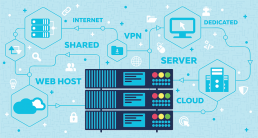
VPS Hosting Comparison To Dedicated Servers
To find the most optimal web hosting solution, prioritize security, scalability, efficient data delivery, and reliable hardware resources. Once you’ve checked all of those boxes, begin to look at the differences between a VPS and a Dedicated Server.
What is a Virtual Private Server?
A VPS hosts the information of many clients on a single physical machine. But unlike shared hosting, it uses a hypervisor to separate tenants.
The VPS is known as a Virtual Private Server as all clients on the server appear as if they were on a separate dedicated machine. The VPS simulates this environment, cutting down on resources and cost.
Virtual private servers differ from shared servers through software and their availability of resources. However, the structure of both is physically similar.
VPS hosting is considered superior in that it offers significantly more resources (memory, computing power, running CPU, or graphics-intensive software or modules) than shared server hosting. A VPS server also provides a guarantee for resources that a client may use, while shared hosting does not.
What is a Dedicated Server?
A dedicated hosting server is, by definition, associated with a single client.
The client has access to the full range of resources on the physical server. This includes all network access, hard drive storage capacity, memory, and processing power.

Advantages of VPS
Pricing
Hosting a server on a virtual machine is often the cheaper solution when comparing VPS vs. Dedicated. The ability to have multiple clients on a single physical space allows the host to divide the cost of hardware operations between everyone.
The client essentially ends up paying for a fraction of the server but has access to the full performance of the hardware: a win-win scenario. Currently, low-end dedicated servers start at around three times the monthly rental price of the average VPS.
Scalability
The virtual environment is much more natural to scale than a dedicated hosting. With a client using only a portion of the available resources on a physical server, those resources can be allocated without any changes to the hardware.
A dedicated server provides client access to the full resource base of the hardware. However, expanding the resources requires adding slots or modules to the physical server. This can be both expensive as well as time-consuming. Also, it usually cannot be done in real time, so extra redundancy measures must be in place to allow for downtime.

Dedicated Server Advantages
Resources
The number one reason that most companies choose a dedicated server is to take advantage of dedicated, full-power resources. No virtual server can match top dedicated servers when regarding CPU power, memory, processing resource-intensive software modules, storage space, and the other hardware-based attributes.
Security
Dedicated hosting is considered to be safer than a virtual one when concerning malicious attacks from an outside source. With only a single client on the server, resources efficiently managed which helps prevent potential security breaches.
You can also manage software installations and other digital expansions with more efficiency. This reduces the potential for a virus or other malicious attack from piggybacking on credible software.
Many experts believe that business data is more secure from internal issues within the virtual environment. So it’s a toss-up on what you believe and how you configure your hardware. Unaccounted backdoors can always increase the possibility of an attack from outside the server. In this case, a virtual space would increase efficiencies to protect a company from the loss of data. It takes automatic snapshots of instances to make it much easier to re-create a specific state in case of information loss. Cloud hosting provides redundancy in real time.
Speed
The dedicated environment is advantageous regarding speed. In a dedicated environment, the virtual layer is non-existent which allows for data pass-through without any latency. This results in faster site load times and requested response actions.

Configuration & Customization
A dedicated server gives the webmaster to configure the server as he/she pleases. There are virtually limitless configurations when it comes to a VPS environment — but they do exist. For example, you obviously can’t install anything that will compromise the security or the integrity of other clients on the server. You also have much less capacity within the VPS environment to install large-scale software packages. Because of the limitations of memory and storage allocation, you may not be able to move in a full stack, depending on how big it is.
Management
If you need reconfiguration or maintenance, the dedicated hosting environment usually proves to be a much more efficient service. With a managed solution, server technicians and software engineers within the dedicated space do not have to wade through competing data streams to get to your problem. Technicians are also less limited in what they can and cannot do on a dedicated server. The lack of a “noisy neighbor” effect allows access to a broader variety of solutions and processes.

VPS vs. Dedicated Hosting: Which Should Your Business Choose?
A Virtual Private Server and a Dedicated Server have their differences. Which one is perfect for your business depends on specific criteria and specifications.
First, there is very little need for small to medium-sized business to invoke the full scale of resources available on state-of-the-art bare metal servers. If a company does not need all of these resources, there is no need to purchase a system that is entirely out of scope. Growing companies with a steady stream of web traffic may find all of the power they need in a VPS environment.
In most cases, a minimal spike in web traffic is not enough to warrant a dedicated server for a small business. Virtual solutions are competitively priced with lower resource requirements. In the SMB space, most competitors live in the VPS space. That makes keeps on the same page regarding speed. The majority of dedicated servers are populated by internationally recognized, enterprise-level companies.
Examine how you will use your hosting service in-house. Do you have the staff to handle on-going maintenance? Can you upgrade hardware internally?
Depending on your answers, you may want to modify your approach. Managed hosting may cost more than traditional hosting, but it can improve your efficiency within the VPS environment to the level of a dedicated server. Although this is undoubtedly more achievable on the lower end of the resource spectrum, it is an aspect to consider.
Another consideration is future growth. Is your company looking to scale? Have you quantified this growth for the next five to ten years?
You should select a platform for the present and five years from now. One aspect that many companies overlook is the ability to scale down as well as up.
If you invest in a dedicated server, you will always pay for the same volume of resources. You may end up wasting money if your needs reduce over time.
Final Word: Virtual Private Server vs Dedicated
The server world is ever-changing and constantly evolving.
With the enhancement of technology as well as the growing number of security threats, it’s impossible to prepare for everything. However, by answering the right questions and having an agile technology plan, your server needs should be met.
The hosted solution that you choose is quintessentially the backbone of your digital operations in your business. Assess your needs without succumbing to the sales baiting of overpaying for unused resources. Don’t try to squeeze performance out of a solution that is priced correctly now, but will not scale later. Compare pricing only after your security, flexibility and configuration needs for your company.
Enterprise-level companies ordinarily have the most specific needs for dedicated servers. Small to medium-sized businesses are often best suited for a VPS. The SMB market also works well with the flexibility that a VPS can afford.
Always remember to consider the reputation of the companies that you shortlist. It’s important to keep in mind that your web host could potentially be a long-term solution – one that will affect the way that you do business now and far into the future. Take your time and make an educated decision when choosing between a virtual private server and the Dedicated environment.
Recent Posts
Cloud vs Dedicated Server: Which Is Best For Your Business?
Your business has a website. Your company might, in fact, be that website. That site needs to be hosted somewhere that has reliable uptime, doesn’t cost a fortune, and loads lightning fast.
Picking the perfect web host has many implications for a business that are far reaching. One constant does remain: every company needs a website and a fast server to host it on.
Even a one-second difference in page response can cost a company 7% of its customers.
In July 2018, Google will be updating their algorithm to including page speed as a ranking factor. Consider the implications if consumers are leaving your pages due to load time and your rankings are suffering.
Load-time is just one of many examples of the importance of web hosting, and its impacts on the company bottom line. The web host a company chooses is vitally important.
To understand the importance of web hosting servers, let’s break down the difference in the two major types of offered services: cloud hosting and dedicated servers.
Both have their advantages and disadvantages that may become more relevant to a company that is on a budget, facing time constraints or looking to expand. Here are the definitions and differences that you need to know.
The Cloud Ecosystem
The cloud is a technology that allows an infinite number of servers to act as a single entity. When information is stored “in the cloud,” it means that it is being held in a virtual space that can draw resources from different physical hubs strategically located around the world.
These hubs are actual servers, often in data center facilities, that connect through their ability to share resources in virtual space. This is the cloud.
Cloud servers use clustered filesystems such as Ceph or a large Storage Area Network (SAN) to allocate storage resources. Hosted and virtual machine data are accommodated through decentralization. In the event of a failure, this environment can easily migrate its state.
A hypervisor is also installed to handle how different sizes of cloud servers are partitioned. It also manages the allocation of physical resources to each cloud server including processor cores, RAM and storage space.

Dedicated Hosting Environment
The dedicated server hosting ecosystem does not make use of virtual technology. All resources are based on the capabilities and limitations of a single piece of physical hardware.
The term ‘dedicated’ comes from the fact that it is isolated from any other virtual space around it based on hardware. The hardware is built specifically to provide industry-leading performance, speed, durability and most importantly, reliability.
What is a Cloud Server and How Does it Work?
In simple terms, cloud server hosting is a virtualized hosting platform.
Hardware known as bare metal servers provide the base level support for many cloud servers. A public cloud is made up of multiple bare metal servers, usually kept in a secure colocation data center. Each of these physical servers plays host to numerous virtual servers.
A virtual server can be created in a matter of seconds, quite literally. It can also be dismissed as quickly when it is no longer needed. Sending resources to a virtual server is a simple matter as well, requiring no in-depth hardware modifications. Flexibility is one of the primary advantages of cloud hosting, and it is a characteristic that is essential to the idea of the cloud server.
Within a single cloud, there can be multiple web servers providing resources to the same virtual space. Although each physical unit may be a bare metal server, the virtual space is what clients are paying for and ultimately using. Clients do not access the operating system of any of the base units.
What is Dedicated Server Hosting?
Dedicated hosting has the potential to have just a single client on a physical server.
All of the resources of that server are available to that specific client that rents or buys the physical hardware. Resources are customized to the needs of the client, including storage, RAM, bandwidth load, and type of processor. Dedicated hosting servers are the most powerful machines on the market and often contain multiple processors.
A single client may require a cluster of servers. This cluster is known as a “private cloud.”
The cluster is built on virtual technology, with the many dedicated servers all contributing to a single virtual location. The resources that are in the virtual space are only available to one client, however.
Mixing Cloud and Dedicated Servers – the Hybrid Cloud
An increasingly popular configuration that many companies are using is called a hybrid cloud. A hybrid cloud uses dedicated and cloud hosting solutions. A hybrid may also mix private and public cloud servers with colocated servers. This configuration allows for multiple variations on the customization side which is attractive to businesses that have specific needs or budgetary constraints.
One of the most popular hybrid cloud configurations is to use dedicated servers for back-end applications. The power of these servers creates the most robust environment for data storage and movement. The front-end is hosted on cloud servers. This configuration works well for Software as a Service (SaaS) applications, which require flexibility and scalability depending on customer-facing metrics.

Cloud Servers and Dedicated Servers – the Similarities
At their core, both dedicated and cloud servers perform the same necessary actions. Both solutions can conduct the following applications:
- store information
- receive requests for that information
- process requests for information
- return information to the user who requested it.
Cloud servers and dedicated servers also maintain differences from shared hosting or Virtual Private Server (VPS) hosting. Due to the increasing sophistication structure of cloud and dedicated solutions, they outpace shared/VPS solutions in the following areas:
- Processing large amounts of traffic without lag or performance hiccups.
- Receiving, processing and returning information to users with industry standard response times.
- Protecting the fidelity of the data stored.
- Ensuring the stability of web applications.
The current generation of cloud hosting solutions and dedicated servers have the general ability to support nearly any service or application. They can be managed using similar back-end tools, and both solutions can run on similar software. The difference is in the performance.
Matching the proper solution to an application can save businesses money, improve scalability and flexibility, and help maximize resource utilization.
The Difference Between Dedicated Servers and Cloud Computing
The differences between cloud hosting and dedicated servers become most apparent when comparing performance, scalability, migration, administration, operations, and pricing.

Performance
Dedicated servers are usually the most desired choice for a company that is looking for fast processing and retrieval of information. Since they process data locally, they do not experience a great deal of lag when performing these functions.
This performance speed is especially important in industries where every 1/10th of a second counts, such as ecommerce.
Cloud servers must go through the SAN to access data, which takes the process through the back end of the infrastructure. The request must also route through the hypervisor. This extra processing adds a certain level of latency that cannot be reduced.
Processors in dedicated servers are entirely devoted to the host website or application. Unless all of the processing power is used at once (which is highly unlikely), they do not need to queue requests. This makes dedicated servers an excellent choice for companies with CPU intensive load balancing functions. In a cloud environment, processor cores require management to keep performance from degrading. The current generation of hypervisors cannot manage requests without an added level of latency.
Dedicated servers are entirely tied to the host site or application which prevents throttling on the overall environment. Dedication of this magnitude allows networking a simple function when compared to the cloud hosting environment.
In the cloud, sharing the physical network incurs a significant risk of throttling bandwidth. If more than one tenant is using the same network simultaneously, both tenants may experience a myriad of adverse effects. Hosting providers give many cloud-based tenants the option to upgrade to a Network Interface Card (NIC).
This option is often reserved for clients who are bumping up against the maximum available bandwidth that is available on the network. NIC’s can be expensive. But companies often find they are worth the extra cost.
Scale Your Business Hosting Needs
Dedicated hosting scales differently than cloud-based servers. The physical hardware is limited by the number of Distributed Antenna System (DAS) arrays or drive-bays it has available on the server.
A dedicated server may be able to add a drive to an already open bay through an underlying Logical Volume Manager (LVM) filesystem, a RAID controller, and an associated battery. DAS arrays are more difficult to hot swap.
In contrast, cloud server storage is easily expandable (and contractible). Because the SAN is off the host, the cloud server does not have to be part of the interaction to provision more storage space. Expanding storage in the cloud environment does not incur any downtime.
Dedicated servers also take more time and resources to change processors without maintenance downtime. Websites hosted on a single server that requires additional processing capabilities require a total migration or networking with another server.

Migration
Both dedicated and cloud hosting solutions can achieve seamless migration. Migration within the dedicated environment requires more planning. To perform a seamless migration, the new solution must keep both future and current growth in mind. A full-scale plan should be created.
In most cases, the old and new solutions should run concurrently until the new server is completely ready to take over. It is also advisable to maintain the older servers as a backup until the new solution can be adequately tested.
Server Management: Administration and Operations
Dedicated servers may require a company to monitor its dedicated hardware. Therefore in-house staff must understand systems administration more closely. A company will also need a deep understanding of load profile maintain data storage requirements within the proper range.
Scaling, upgrades, and maintenance is a joint effort between client and provider that must be carefully engineered to keep downtime to a minimum.
Cloud servers are more accessible to administer. Scalability is faster with much less of an impact on operations.
Where dedicated platforms require planning to estimate server requirements accurately, the cloud platforms require planning to work around the potential limitations that you may face.

Cloud vs Server Cost Comparison
Cloud servers ordinarily have a lower entry cost than dedicated servers. However, cloud servers tend to lose this advantage as a company scales and requires more resources.
There are also features that can increase the cost of both solutions.
For instance, running a cloud server through a dedicated network interface can be quite expensive.
A benefit of dedicated servers is they can be upgraded. With more memory, network cards and Non-Volatile Memory (NVMe) disks that will improve capabilities at the expense of a company’s hardware budget.
Cloud servers are typically billed on a monthly OpEx model. Physical server options usually are CapEx expenditures. They allow you to oversubscribe your resources without additional cost. You now have a capital expenditure costs that may be written off over a three year period.

Making a Choice: Cloud Servers vs Dedicated Servers
Matching the needs of your business to the configuration is the most crucial aspect of choosing between computing platforms.
This computing platform needs to complement the operating procedures, be scalable, and cost-effective. These variables are critical evaluators when selecting between a cloud or dedicated server solution.
Also, you are not able to take advantage of the new technological benefits as rapidly as you would in a cloud environment.
The value proposition for bare metal technologies is in the historical evidence that suggests most server workloads take advantage of a fraction of the actual physical resources over an extended period. By combining workloads on a single hardware platform, one can optimize the capitalized expenditure of that hardware platform. This is the model cloud service providers use to create cheaper computing resources on their platform.
A dedicated server provides access to raw performance, both processor and data storage. Depending on the computing workload, this may be necessary.
There is a place for both. Utilizing a hybrid strategy, an organization can processor-intensive workloads on dedicated systems. While also running their scalable workloads on cloud infrastructure, taking advantage of the strengths of each platform.
With the current maturity of cloud orchestration tools, and the ability to cross-connect into cloud environments, an organization can have multiple workloads in various environments. Additionally, it can run physical infrastructure that interacts with these cloud services.
Which should you choose? Selecting one over the other based on a single metric is a mistake.
Consider the following:
- The advantages of each solution.
- The current needs of your business.
- Your future scalability needs.
Have Questions?
Not sure which hosting option to choose for your business needs? Contact one of our hosting service experts.
Recent Posts
Secure Data Storage Solution: 6 Rules to Making the Right Choice
As your business grows, so does your need for secured professional data storage.
Your digital database expands every day with each email you send and receive, each new customer you acquire, and each new project you complete. As your company adopts new business systems and applications, create more files, and generate new database records, it needs more space for storing this data.
The trend of massive digital data generation is affecting every business. According to analyst reports, the demand for data storage worldwide reached nearly 15,000 exabytes last year. With such an impressive figure, it is clear why choosing a professional storage solution is a frequent challenge in the business world.
What companies are looking for in a data storage solution
The rapidly growing data volume is only one of the challenges businesses are facing. As you compile more files, you also need better data protection methods. Securing mission-critical files and databases is a number one priority for today’s businesses that are increasingly exposed to cyber attacks.
You also want to ensure the data is accessible to your teams at any point. Whether they are working remotely or using multiple devices to access business documents, you need to provide them with easy and secure access to your company’s file system.
These are just some of the reasons why choosing secure data storage can be a tough task. When you add cost considerations to these reasons, the issue becomes even more complicated.
Most business execs do not understand storage access methods, performance, redundancy, risk, backup, and disaster recovery. This makes things much more difficult for IT administrators who need to justify the cost of additional storage requirements.
So why is storage so challenging to tackle and manage?
Most small businesses have limited storage systems, lacking the ability to expand as their needs grow. Their IT departments are left to deal with the challenge of handling high costs of storage along with the cost of security systems and software licenses.
Larger businesses, on the other hand, have an issue of finding a solution that is both flexible and secure. This is especially important for companies operating in regulated industries such as Financial Services, Government, and Healthcare.
Whatever the focus of your business, your quest for a perfect professional data storage solution may get complicated.
1. Assess your current and future data storage needs

The first rule businesses should address is their current and future data storage needs.
Do you know the minimum storage requirements for your applications, device drivers, etc.? Of the space you have left, do you have enough to sustain business needs for the next five years?
If you are unsure, you can assess the amount of storage you have now and compare it to your needs in five years. Sure, you can restrict the size of your employee’s inboxes and the amount of storage they can use on the company shared drive. However, how long will your business be able to sustain these restrictions? You will get to a point where your business outgrows your data storage.
As you continue to add new customers and prospective client information to your customer relationship database (CRM), you can expect to see an exponential need for more storage. Even if you take precautionary measures to remove duplicate entries in your CRM and perform routine data cleanup, your need for additional storage will continue to grow. As your applications require updates and patches and you continue to add new apps to your business, your needs for more storage to house all of it will keep growing.
2. Consider storage functionality that you need
After you assess your current and future needs, considering data storage functionality is the next most important thing to consider. Although it is a fundamental aspect, it is easily overlooked. After all, what function does data storage perform anyway?
You should have already answered the question of why you are purchasing storage by this point. Typically, the goal is to lower IT costs, improve productivity, or support business expansion. Instead of having to buy physical servers or add hard drives that you have to maintain, you can centralize your data storage and management in the cloud.
The cloud would help you increase network performance and make data more accessible to your employees. Moreover, it will make your critical assets available in case of a system failure. These are just some of the factors that should drive you toward the optimal solution for your needs.
You will need to determine whether a shared public cloud would suit your needs well or whether you should consider a private option. Both have their advantages and are tailored for businesses with different needs. If your idea is to share less sensitive information in the public cloud, you may not need to invest significantly in data storage expansion. Dedicated and more secure storage options, which can meet the highest storage security and compliance needs, may be more expensive.
This is why you need to ask yourself what is it that you need right now and what goals you want to achieve in future. The answers to these questions also provide you with a starting point for your decision on which type of storage solution is right for your business.
If you do not know or cannot determine the storage function, you can assume that a shared solution is not necessary. Many small businesses do not need dedicated server providers anyway.
However, it all depends on where you forecast your business will be in a few years. If your organization is reliant on building a large customer base, you may consider mapping out how many customers or potentials you will have and how much storage each data record requires. Multiply that by the number of records you plan to have, and calculate a rough estimate of necessary storage.

3. Redefine your information security processes
Data security is a vital issue to address when choosing and implementing a storage solution. Without a sound storage security strategy in place, you risk losing your sensitive data. With the frequency of data breaches becoming more and more alarming, you should integrate security solutions into each step of your data management process.
Many businesses risk losing data stored on their infrastructure due to platform vulnerabilities or poor security management practices. This is especially true for companies using public or hybrid cloud solutions, where a third-party vendor carries part of the responsibility for data security.
While the cloud is not inherently insecure, the lack of storage security best practices and specialized data security software make your cloud data more vulnerable. To protect data adequately, you need to implement information security best practices on multiple levels in your company.
This involves training your employees on the best practices of cybersecurity, implementing new physical security procedures, hiring data scientists, and developing disaster recovery plans. If your data is stored on multiple platforms or with different providers, this may become a complicated issue, so you need to consider it before you make your choice.
You should keep the operational aspects of security in mind when choosing data storage such as security devices, security administrating, and data monitoring. Is your data encrypted in storage and transit?

Just because cloud storage is vulnerable doesn’t mean your data should be. Understand where your data is stored, how it is transferred, and who has access to the keys. For instance, what would an outage mean to your business? Do you have a valid SSL certificate? Does your CA have a good reputation? Some of the most recent major outages occurred because the SSL certificates were expired.
In addition to this, consider the type of data you backup. Sensitive data should be encrypted and secured separately from non-sensitive data. Many businesses use the hybrid cloud to ensure their critical data is stored on an impenetrable platform and protected by different types of data security measures.
You also need to enforce a strict data usage and storage policy company-wide. Employees should become aware of the sensitive nature of their customer information, as well as the best ways to protect data. With comprehensive security training, your employees can become the best guardians of your critical files.
4. Data backup and deduplication options
Another rule to consider when selecting a professional data storage solution is deduplication.
This is the process of identifying unique data segments by comparing them with previously stored data. With an autonomous backup, the same data can continuously be saved after deduplication is complete. Why save and backup duplicate data in the first place? The deduplication process saves only the unique data in a compressed format.
Deduplication reduces your storage requirement by eliminating any redundant data or information found. This also helps improve processing speed by reducing the server workload. Additionally, deduplication reduces the amount of data you have to manage and increases data recovery times.
Imagine the processing power you expend on sifting through gigabytes upon gigabytes of duplicate data, not to mention confusion of which files are relevant. Another way to think of why deduplication is essential to your data storage, you could end up paying for more storage than you need. You may end up saving money by eliminating duplicate data because you will not have to scale up your data storage.
You may find that deduplication offers more storage space that you are already paying for. You could use this newly found storage for applications or other storage needs.
Deduplication is a method of decluttering folders and databases. Depending on your data, this process could be performed through either manual or automatic processes. Your first step could be to find tools that seek similar data or files because you may not be able to find duplication easily. Once you find it, just delete or determine if you need it or not.
5. Compare speed and capacity of different solutions
Once you have chosen the storage option, you can determine the performance and capacity you need. Capacity is easy to determine and the most obvious function. Performance can be easy to explain but hard to quantify. You may have a hard time determining the needed bandwidth, latency, and burst speeds.

While there is a debate among IT professionals about processor speed versus storage, all you care about as a business owner is the performance of the storage you are paying for. In this case, you may wish to do a little research on which processors can yield the best performance for data storage. If you have selected a shared storage solution, find out what processors the storage provider uses.
You do not need a complete understanding of processor speeds. However, consider this: a dual or quad core processor of 2.8 GHz is better than a single core 3.4 GHz processor. Two cores run two programs simultaneously at 2.8 GHz, while the single core 3.4 GHz processor must share the processing power. This means that the 3.4 GHz processor is limited to operating at 1.7 GHz. In addition to processor speeds, memory speed should be adequately matching as well.
6. Find a provider on which you can rely
If considering moving to or buying additional shared storage in the cloud, consider the reliability behind it. You need to choose a credible vendor or a data center provider and ensure the service level agreement (SLA) is tailored to your needs.
A Service Level Agreement should list the acceptable amount of downtime, reliability, redundancy, and disaster recovery you should expect from a shared storage solution. You also need to consider your provider’s data security methods and data security technologies. This would give you peace of mind considering the availability of your data even in case of a disaster.
You should have your IT administrator chime in on this one because reliability o means the difference between having to wait hours or days for recovery in the event of a catastrophic failure. Even if you do not think you will need to access your data storage solution hourly, daily, weekly, or monthly, you need to ensure it is there when you need it.
The concepts of availability and redundancy are equally important. You should not think of storage as just a typical server. In almost all cases, data storage solutions are built and managed through enterprise servers all with the same physical components. Small businesses should look at a mid to high-end storage provider to support their lower-end servers. Regardless of the size of your company or the size of the servers your data storage resides on, all principles of reliability apply. You will have to weigh reliability and security risks and determine the best choice for your business.
For example, do you plan on using this storage for legacy data you might only access once a quarter or once a year? In this case, the reliability of storage will not be as critical as the data your employees need to access daily and hourly.
Conclusion: Finding a Secured Provider Of Data Storage
In summary, your need for professional data storage will grow along with your business. So will your need for a comprehensive and up-to-date security strategy.
To overcome this challenge, you need to perform an initial assessment of your current and future data storage needs, research storage vendors, and security options. Once you have a clear picture of the functions and needs your storage platform, you should consider how you can secure it adequately.
Building a security architecture that meets all your needs for flexibility and scalability may turn out to be a complicated task. Cloud computing does offer flexible, but you still need strong security and data management strategies to maintain the highest level of safety for your data. This is why choosing a secure storage option is an essential part of a company’s digital transformation strategy.
With the right solution, you can optimize all your critical processes. By following the tips outlined in this article, you increase your chances of making a great decision.
Recent Posts
How to Keep Your Web Hosting Customers Happy?
If you are a web hosting company, you might be facing the need to re-invent your business model. Regardless whether your servers are owned or leased; if you are paying for server colocation hosting in a top-notch data center facility or using a VPS solution.
There is one factor that’ll set you apart from the rest of web hosting providers out there – your clients’ satisfaction.
